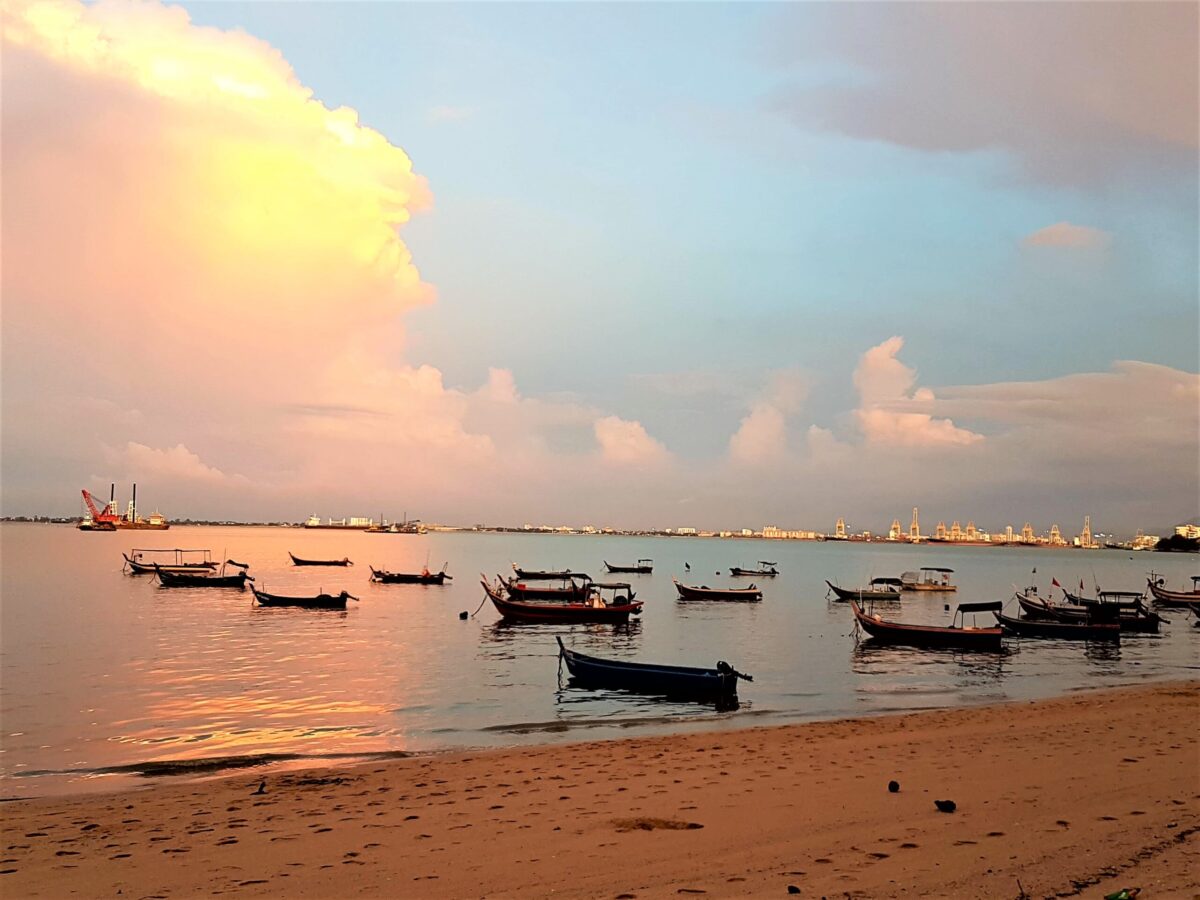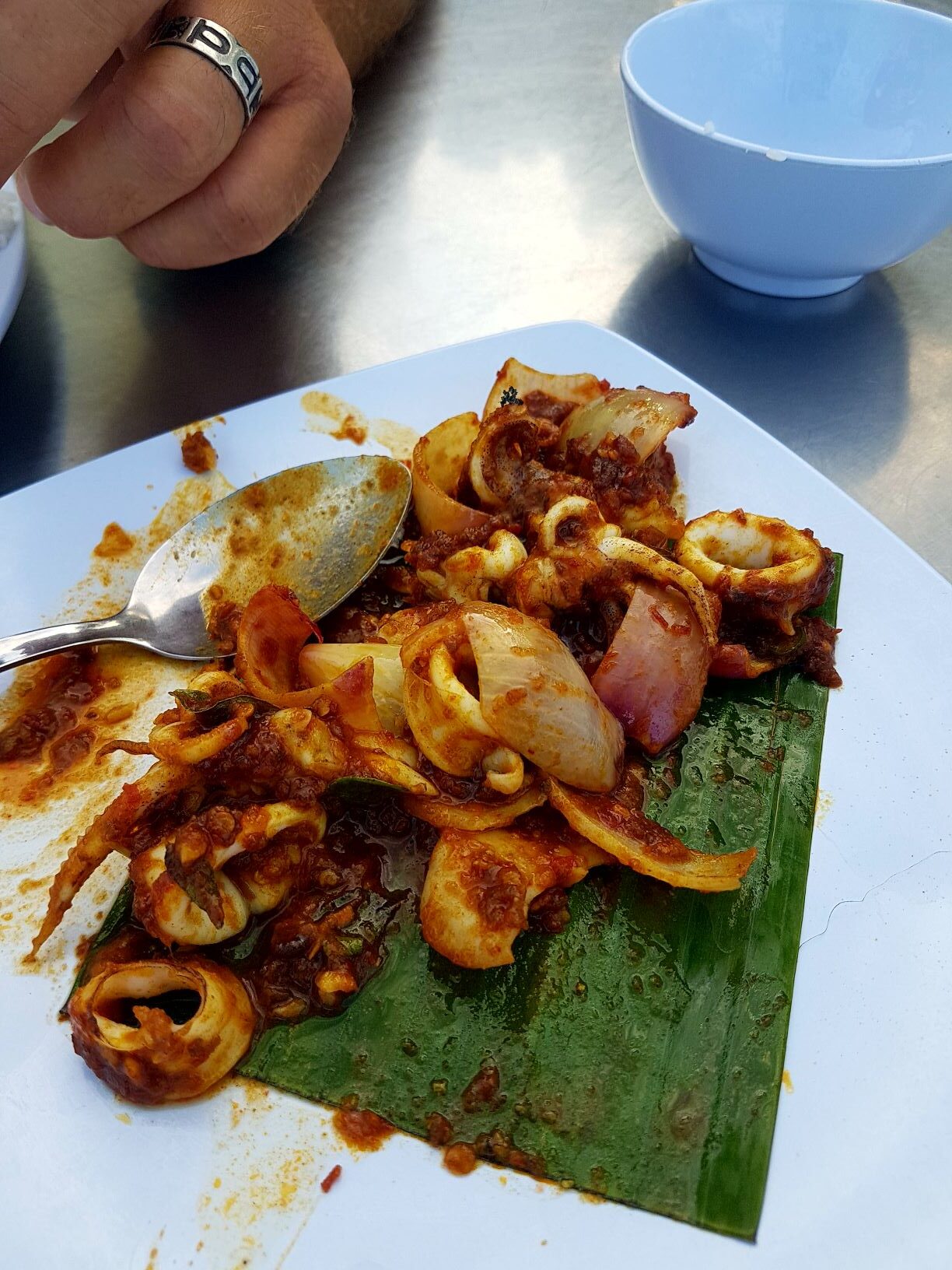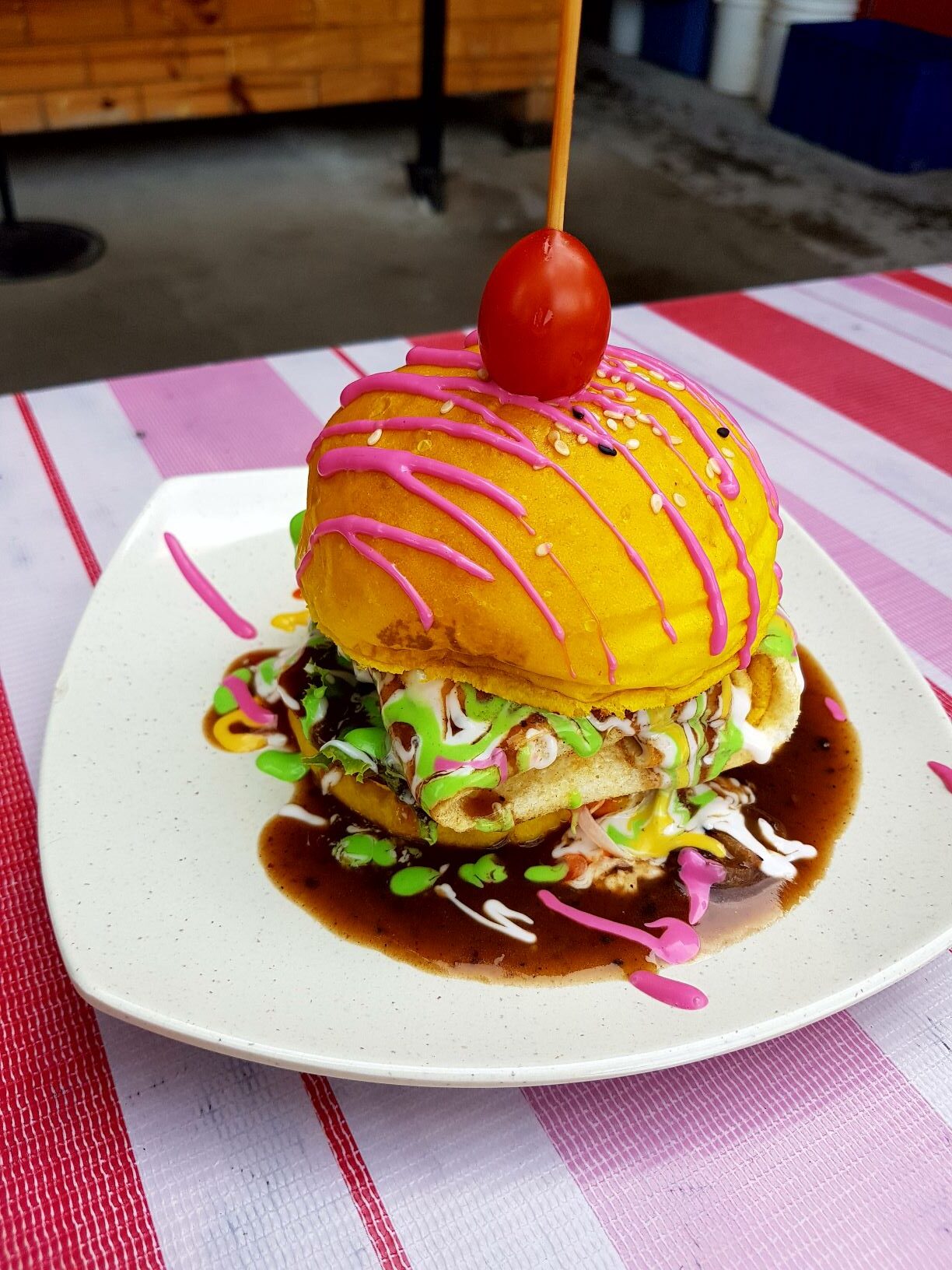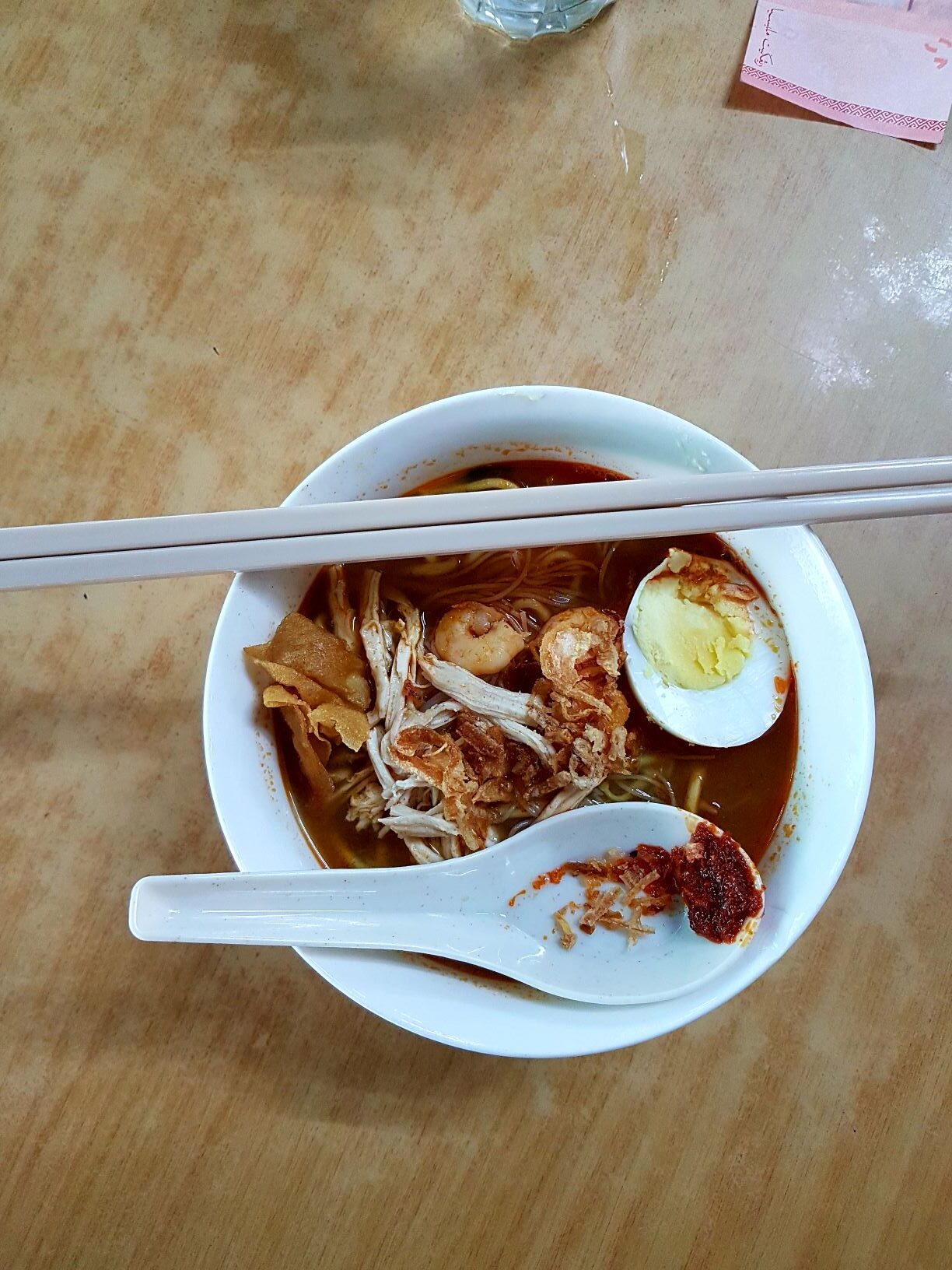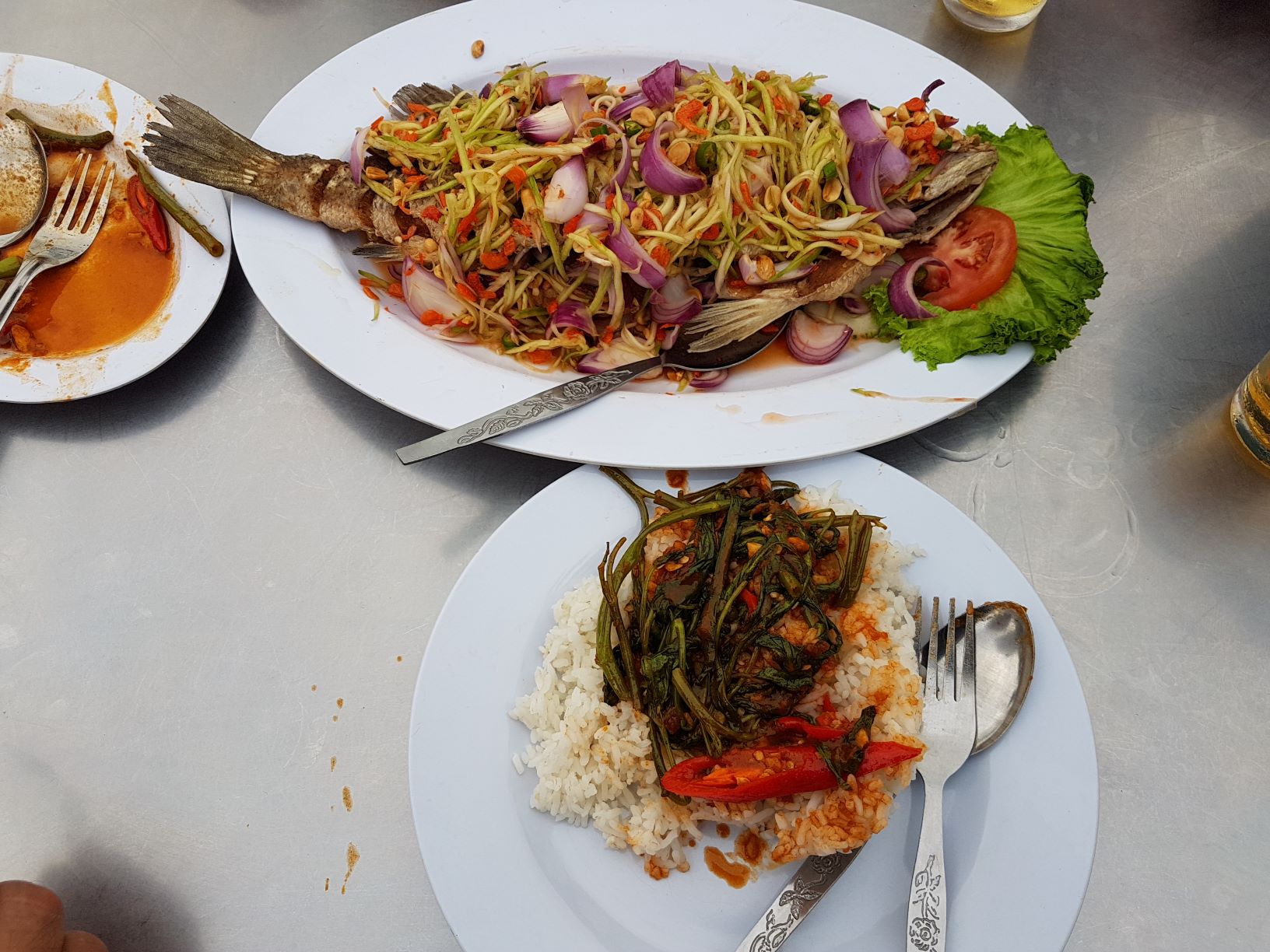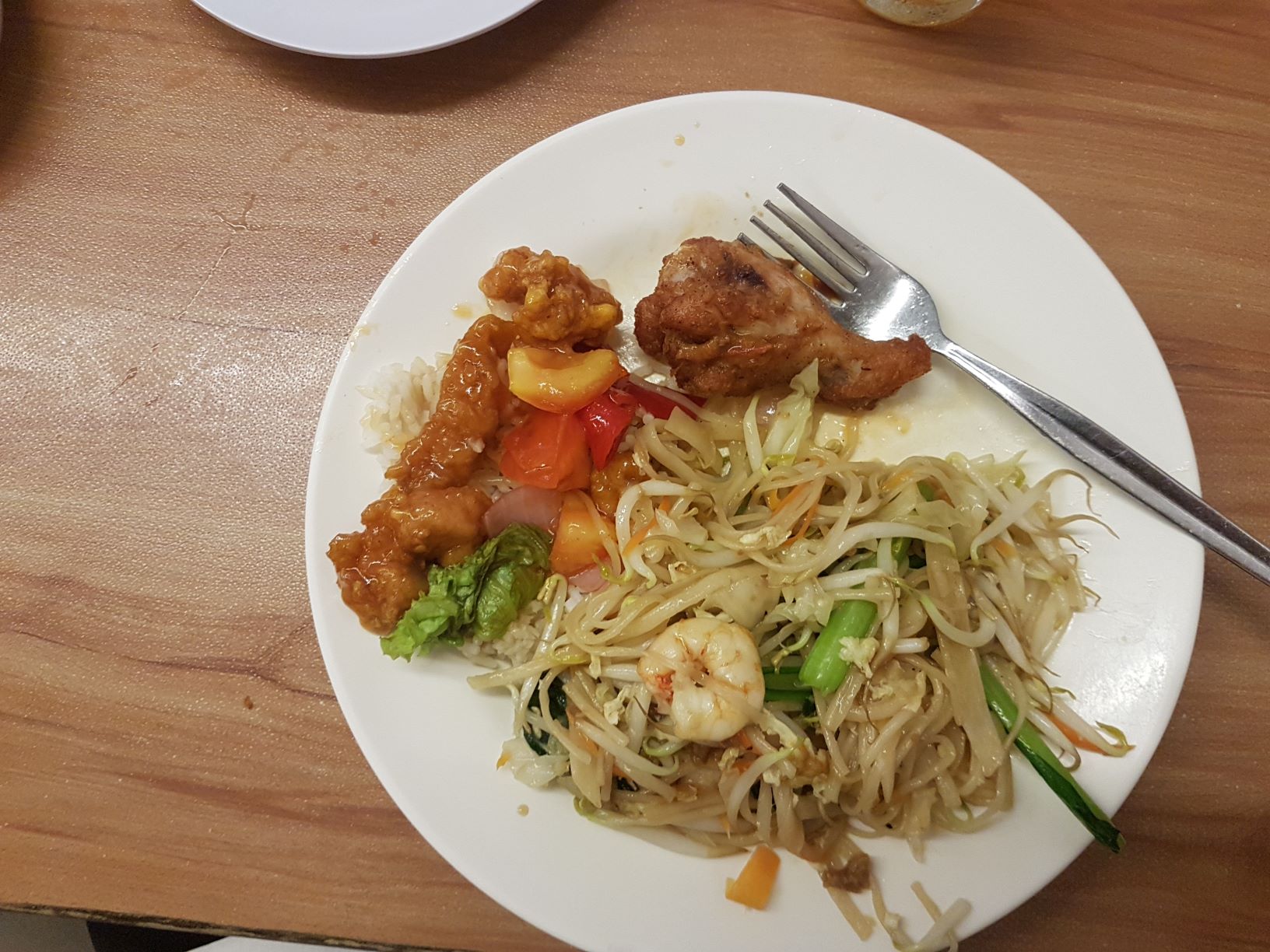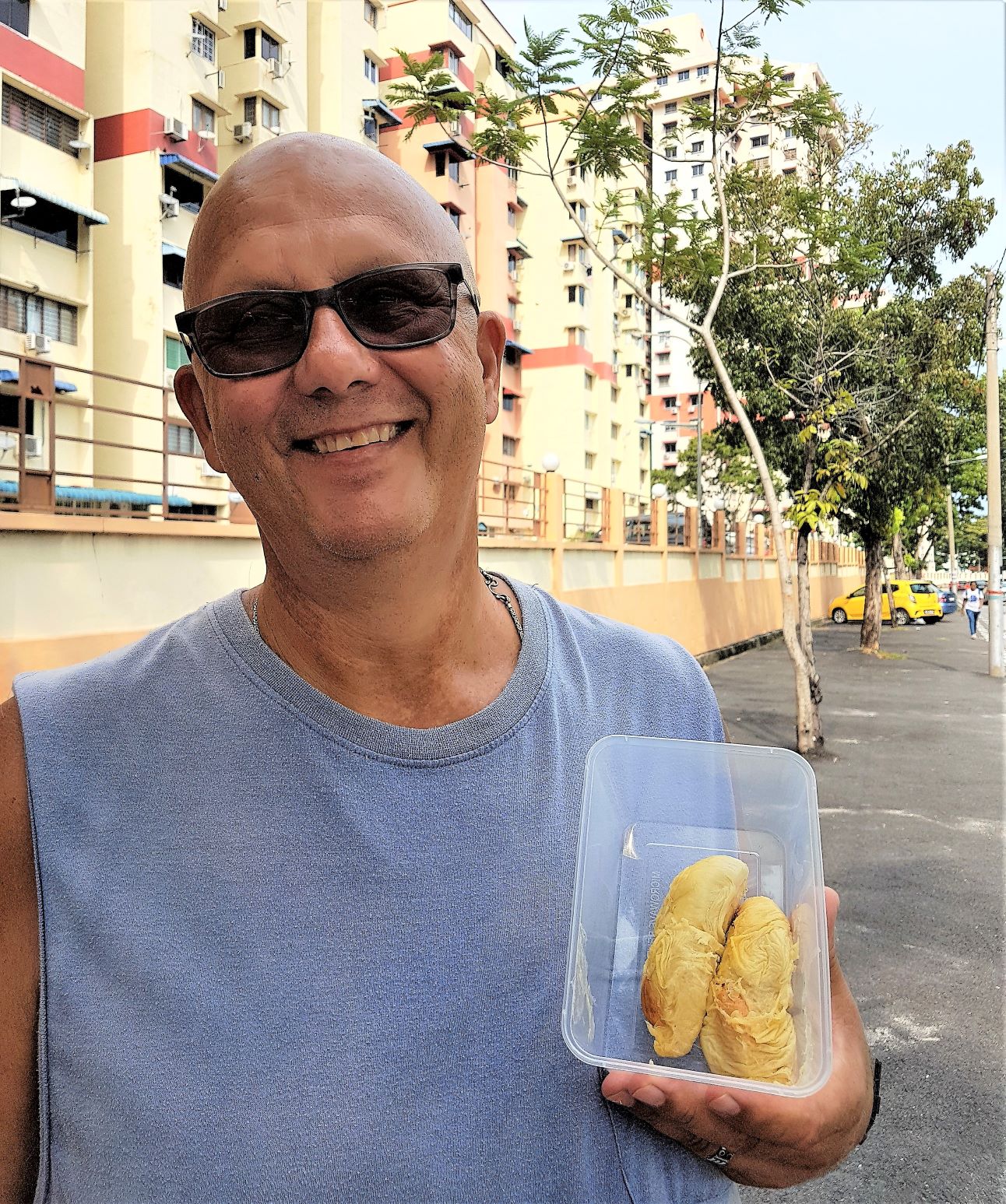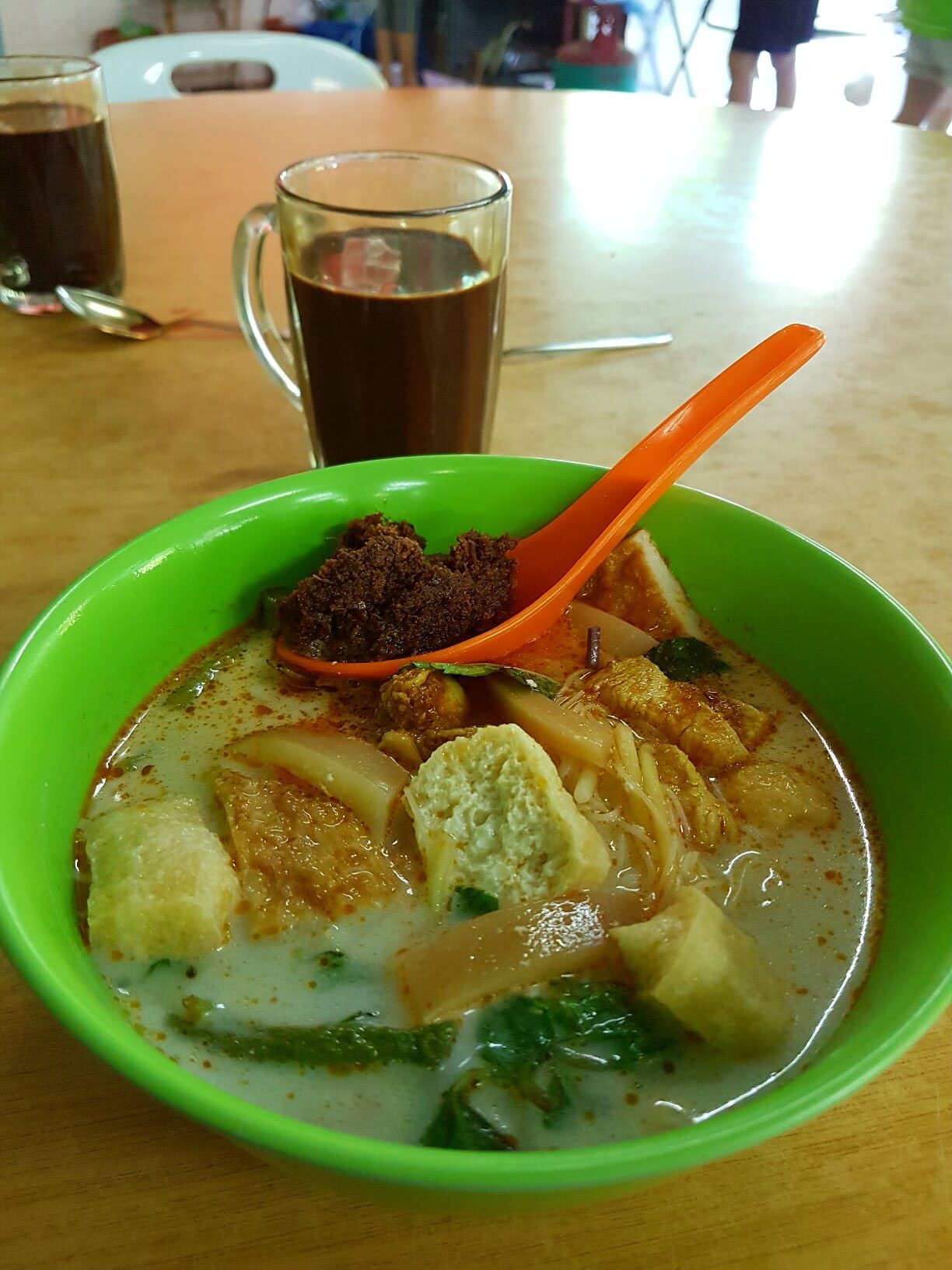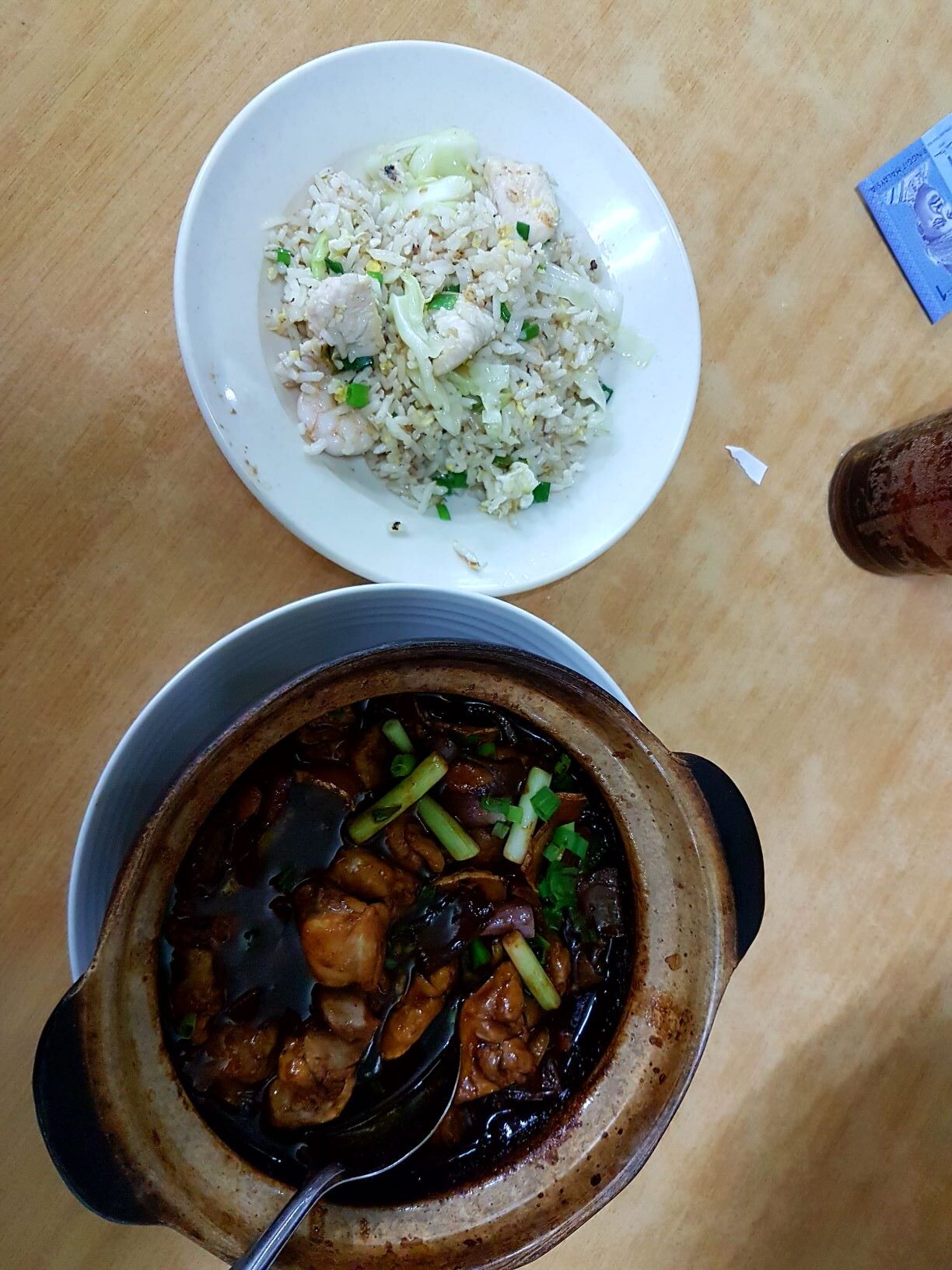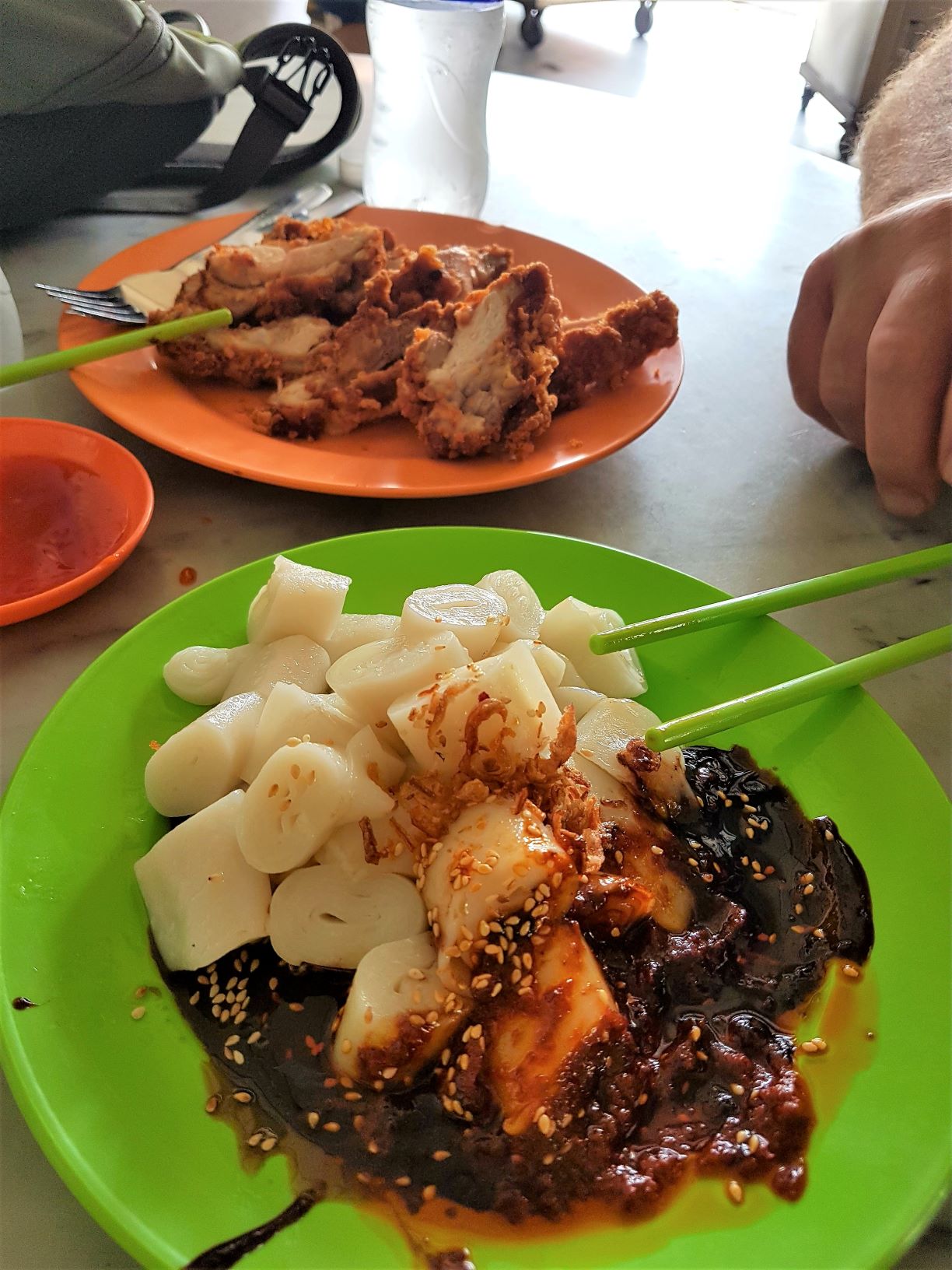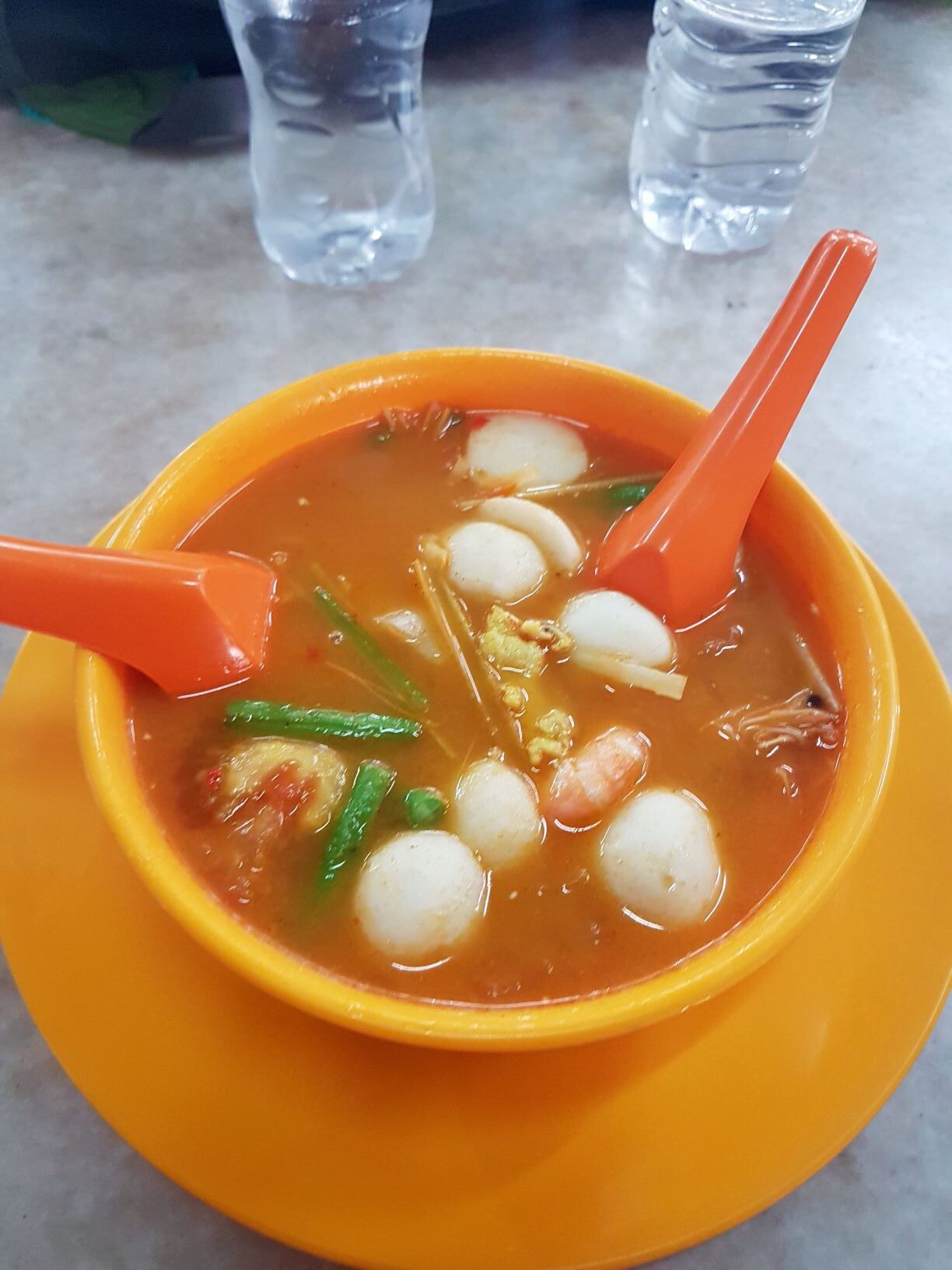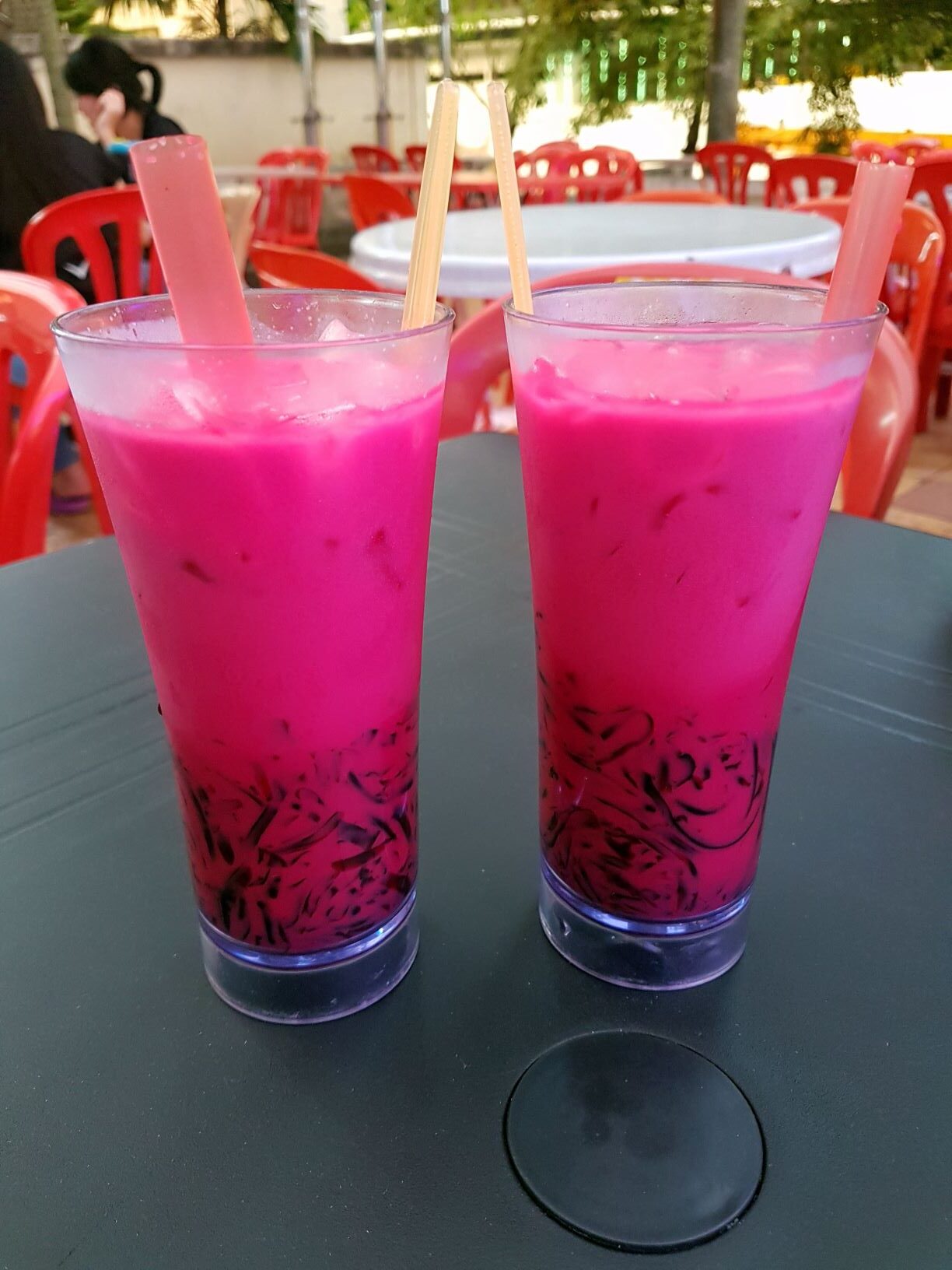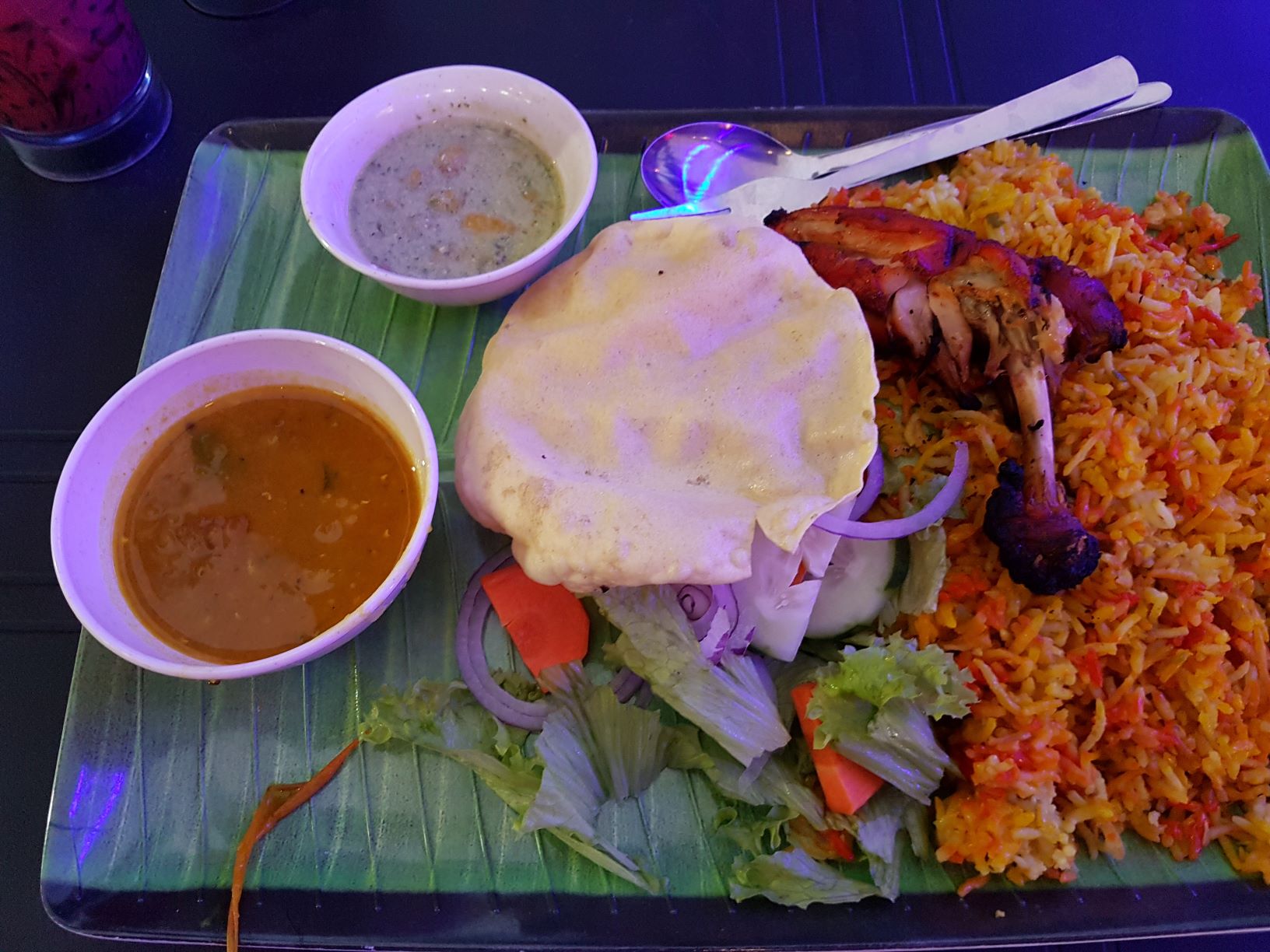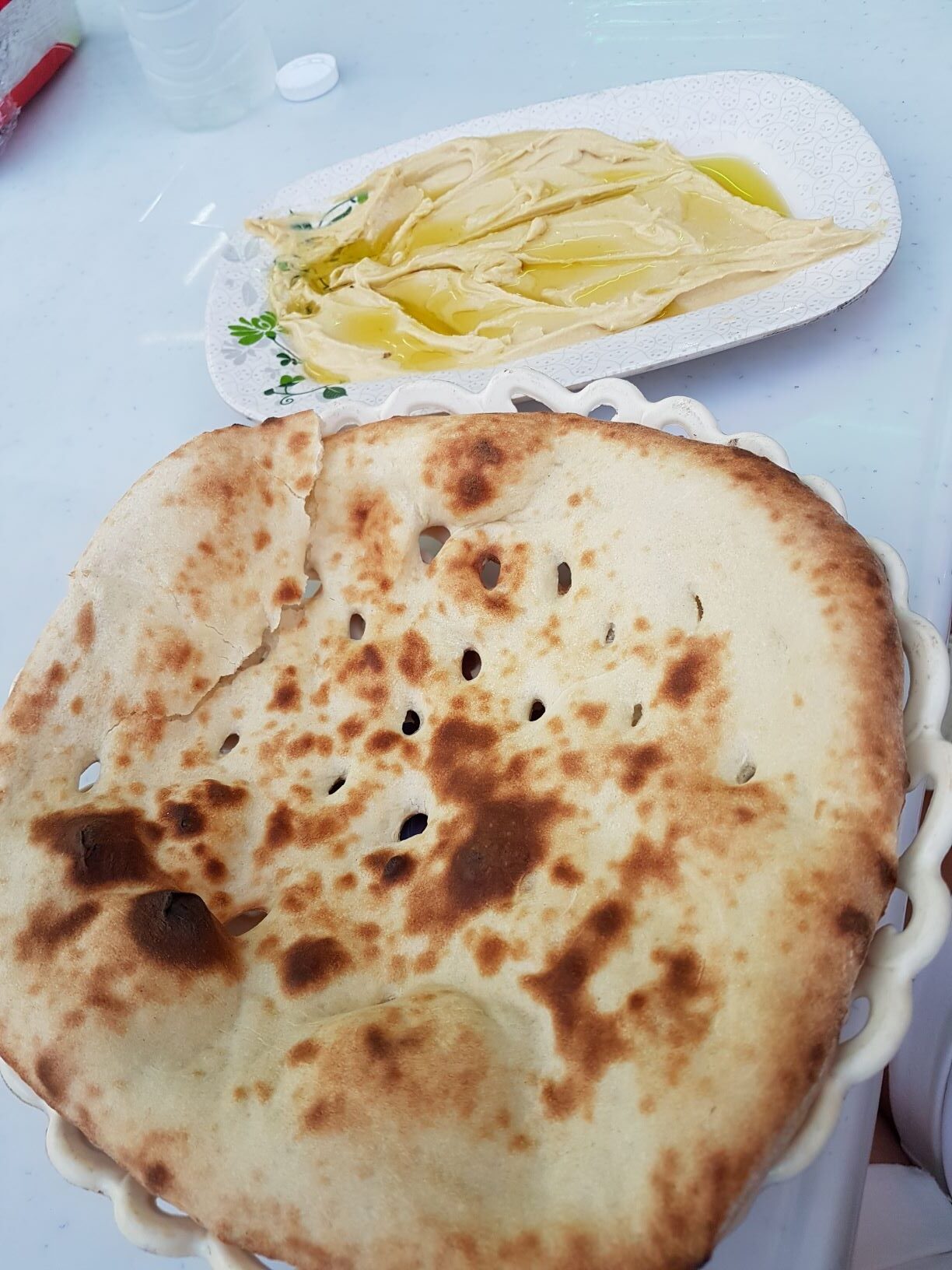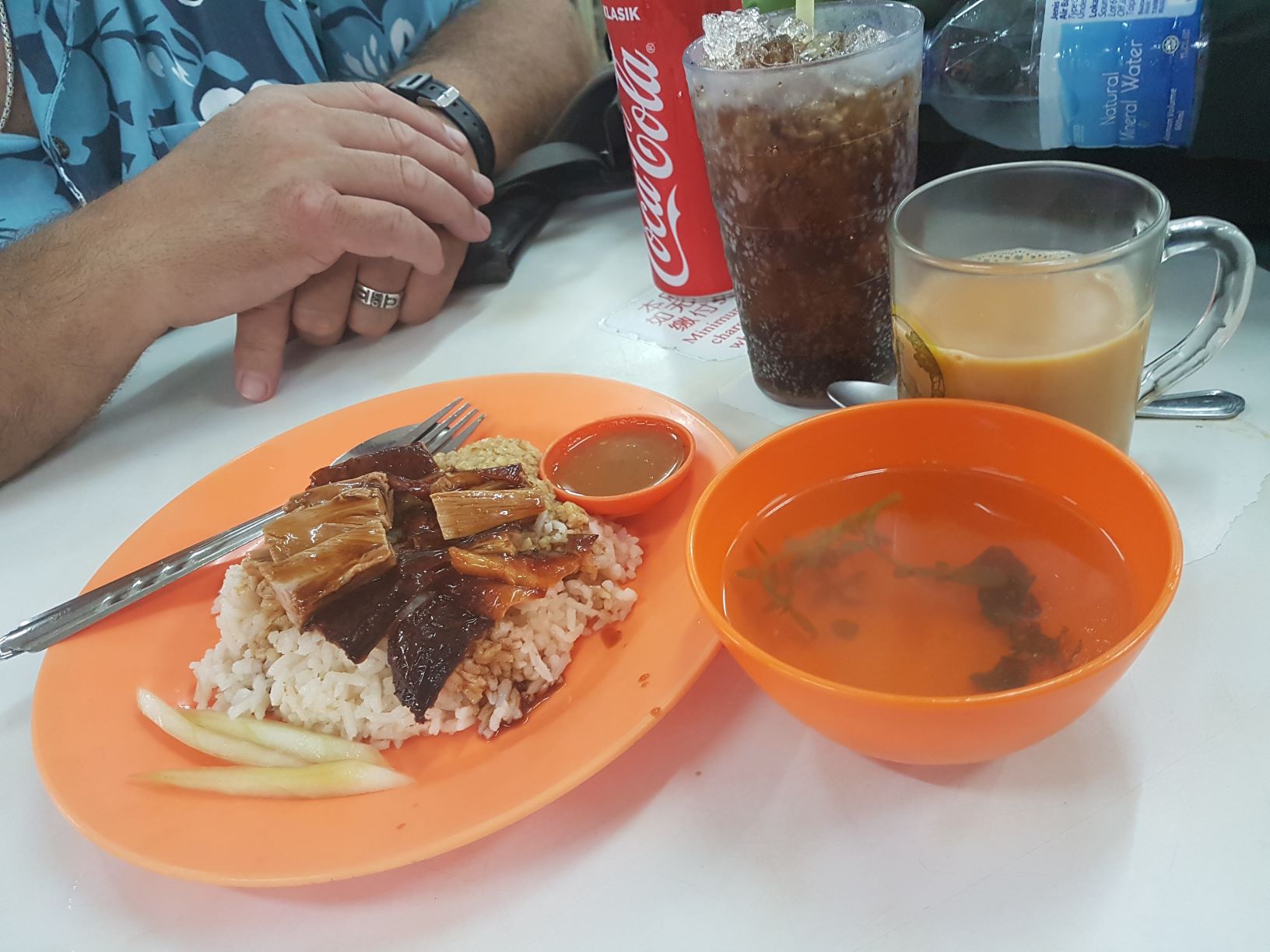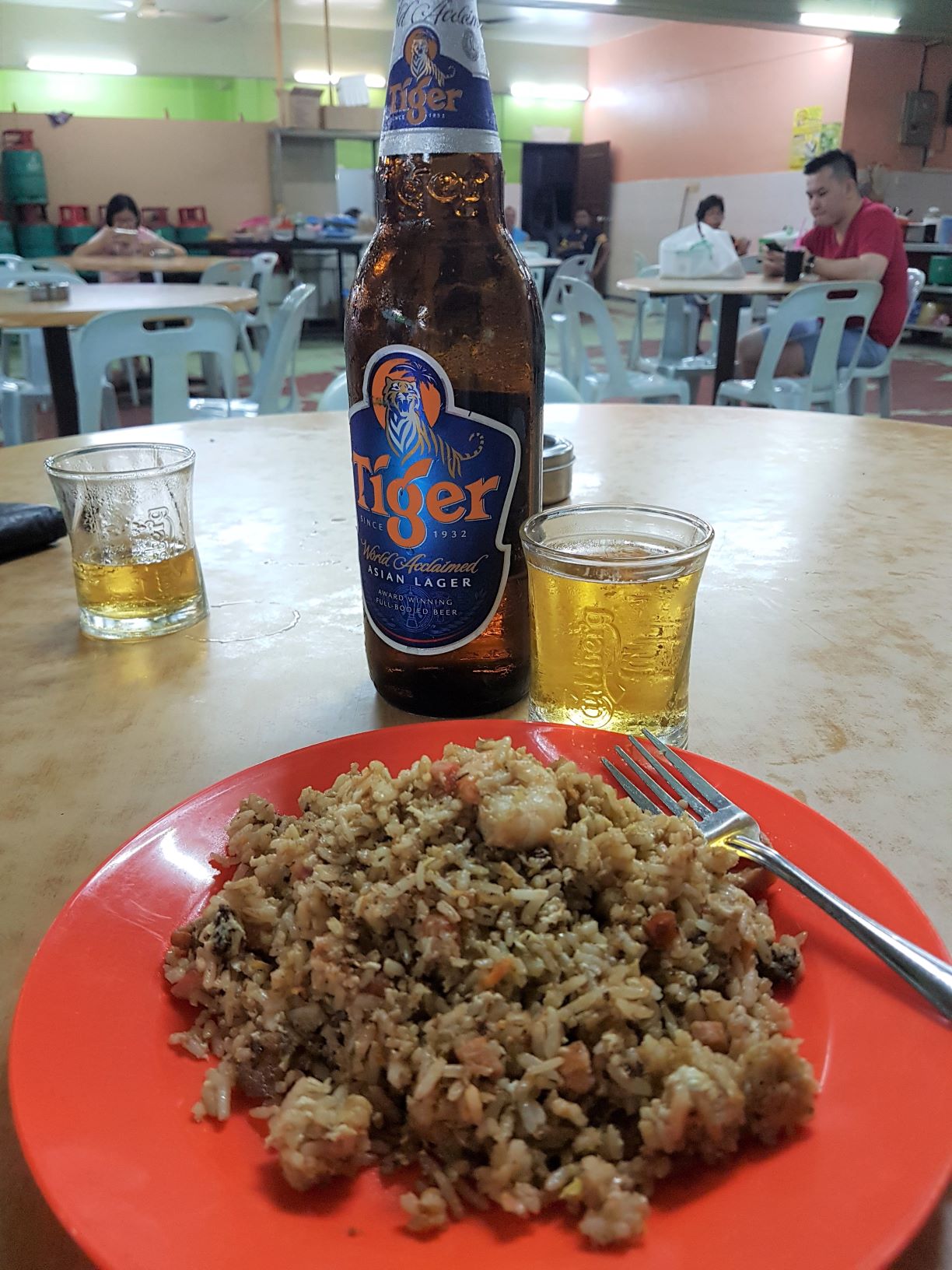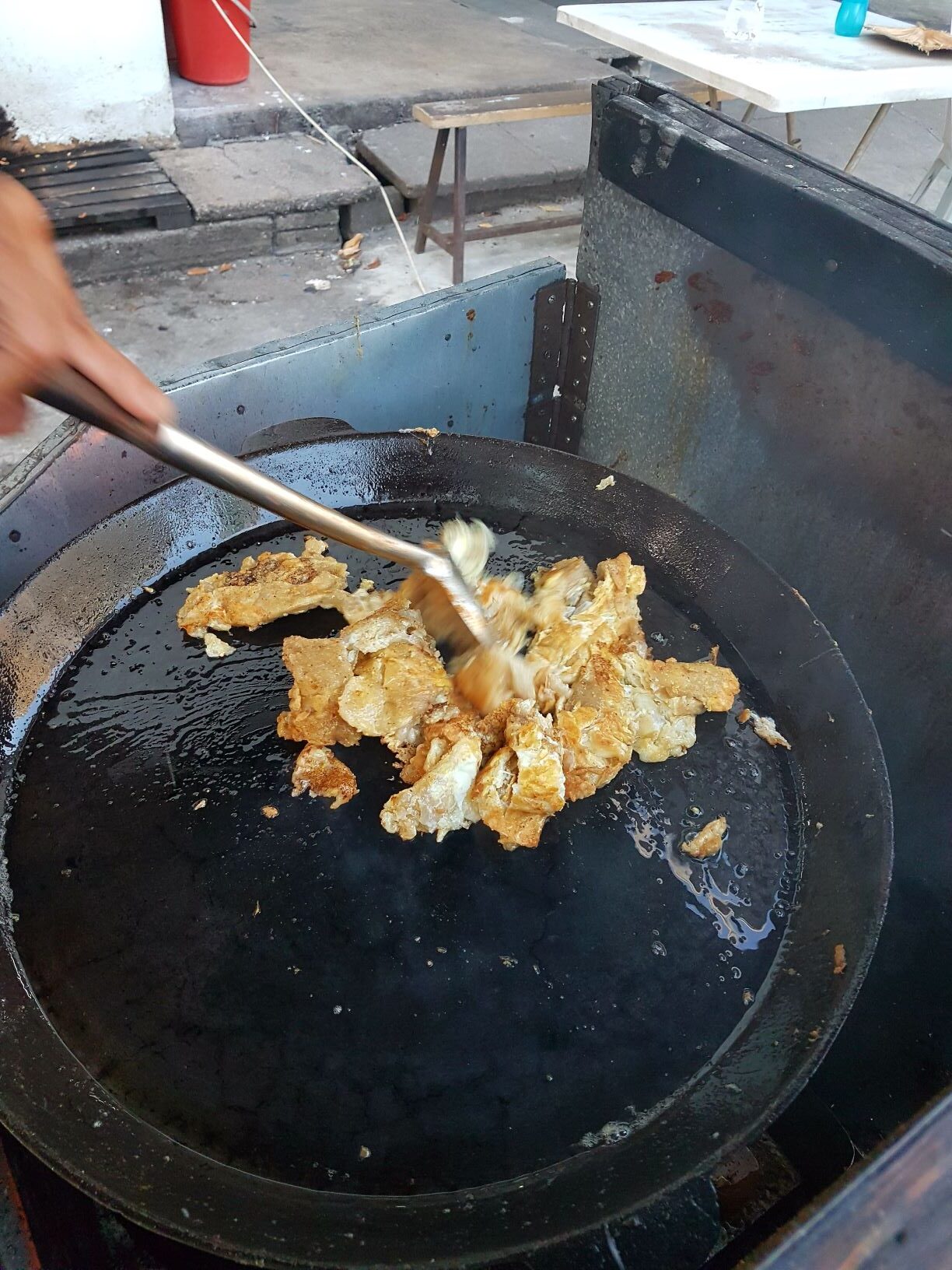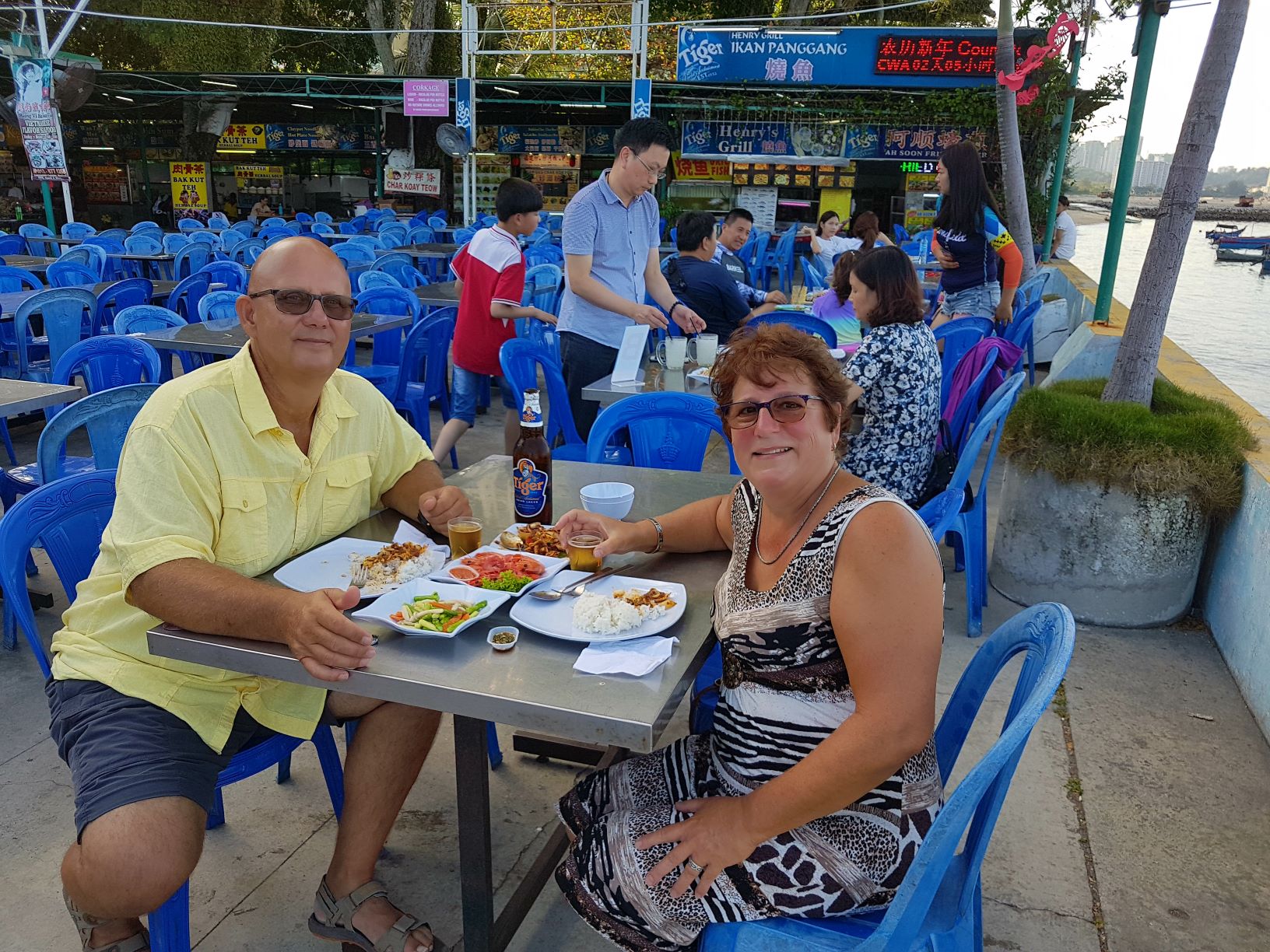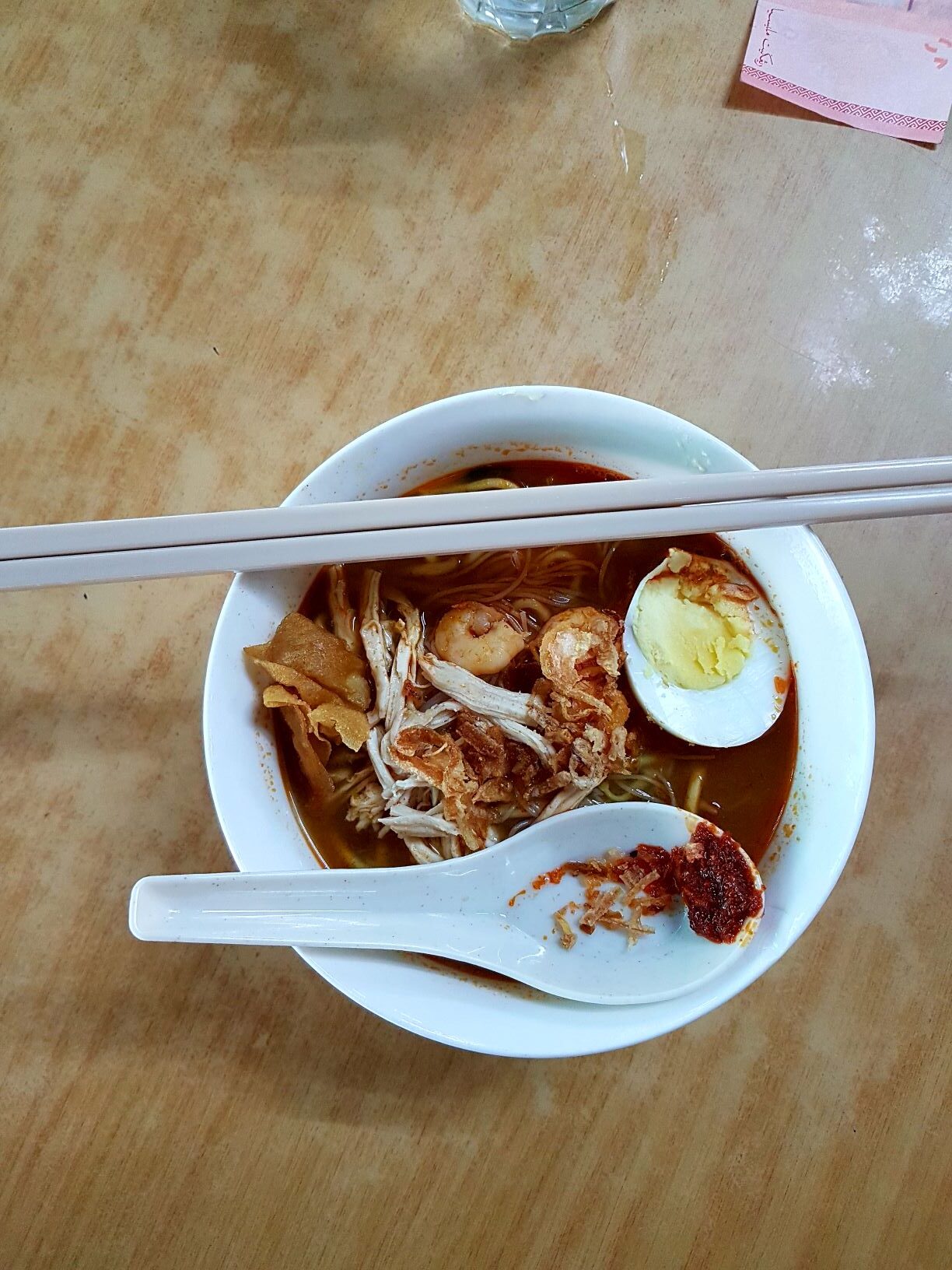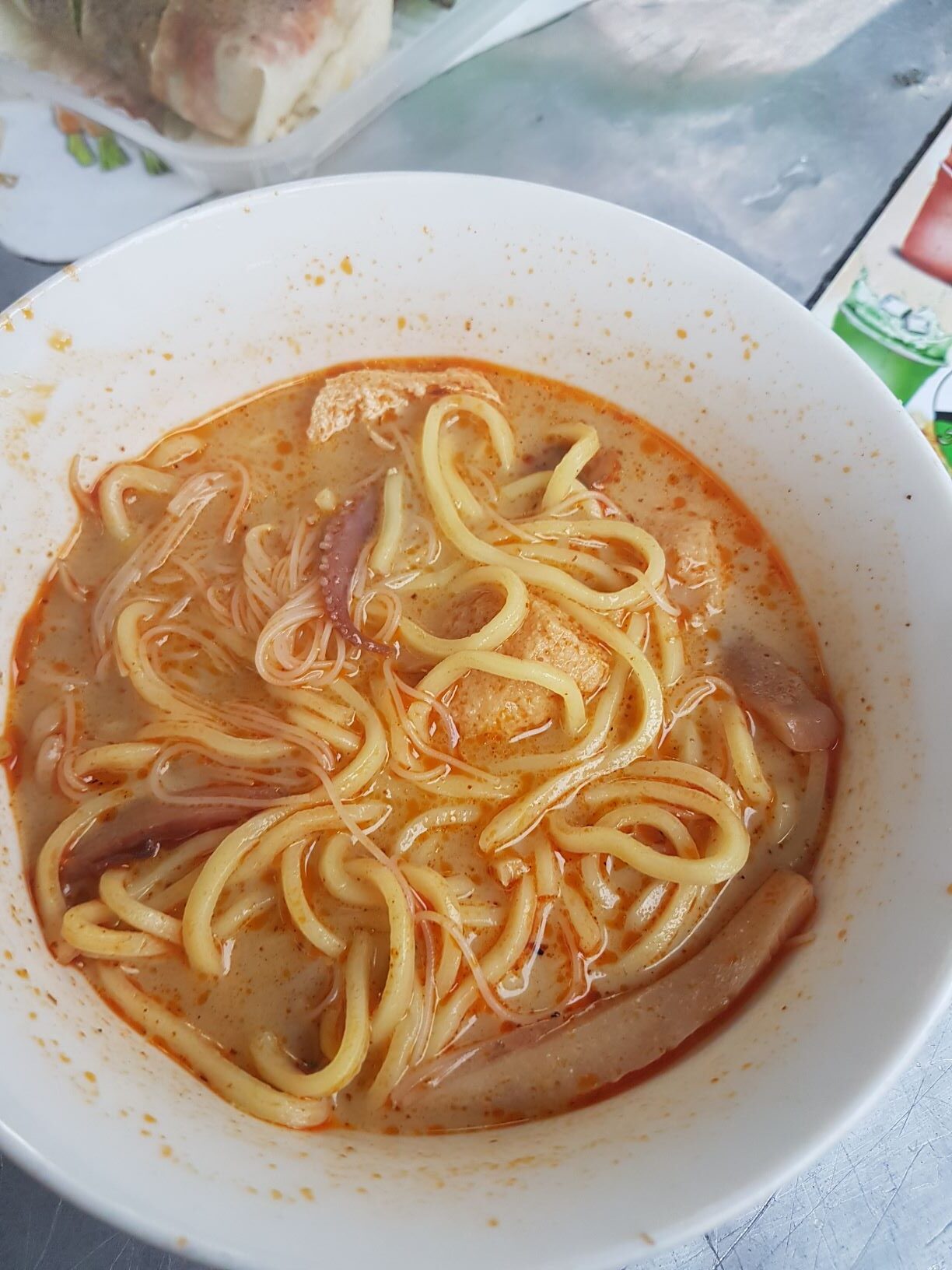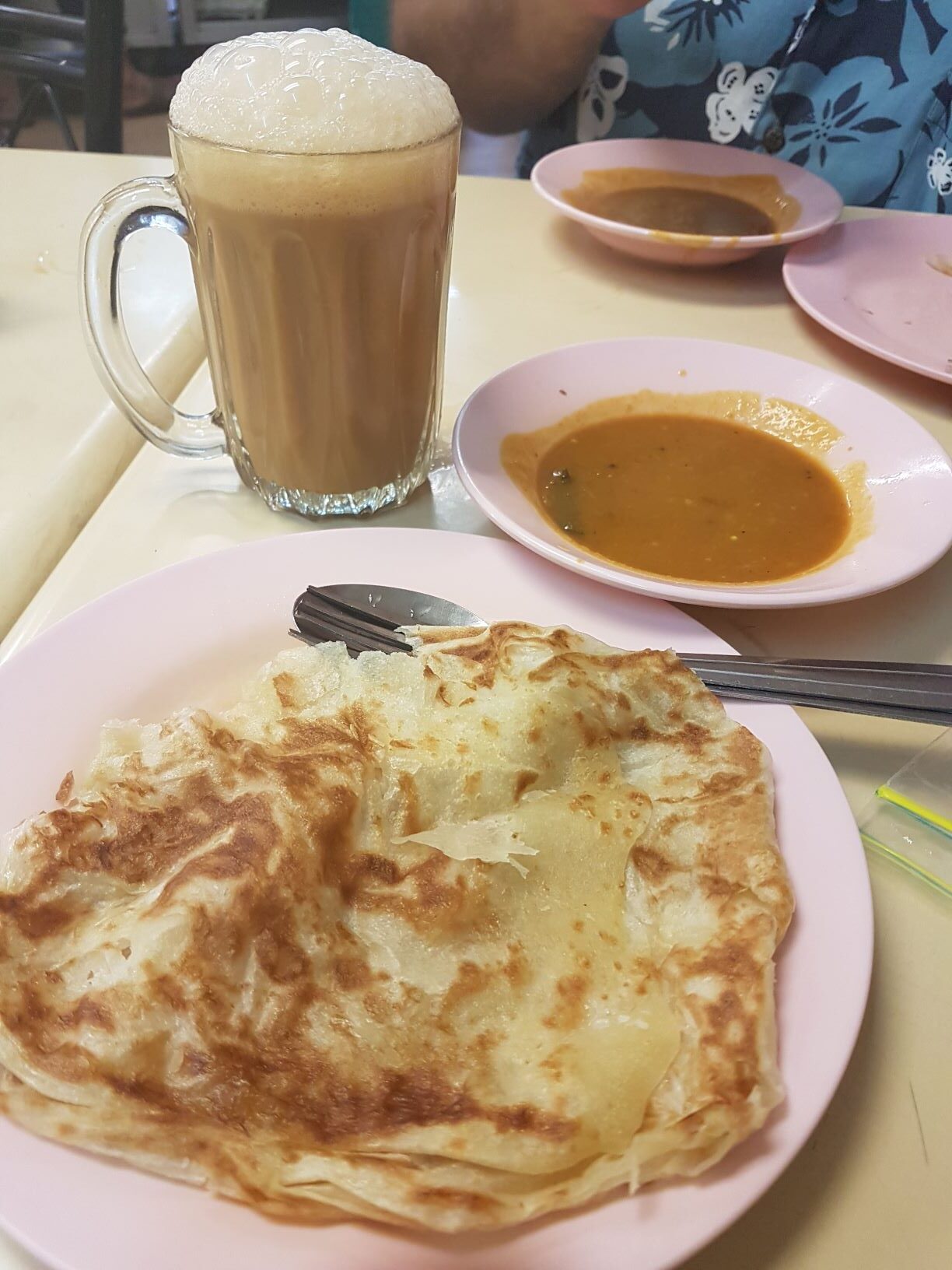Penang’s Beginnings
Penang is full of history and culture, a state in Malaysia located in the Strait of Malacca, consisting mainly of an Island called Penang Island and a small area on the mainland. George Town is Penang’s state’s capital, founded as Fort Cornwallis in 1786 by Captain Francis Light of the British East India Company and flourished as a port of call for shipping on the India-China run.
The port activities attracted Chinese and Indian traders to the area. Consequently, with this infusion of traders, today, Georgetown is known as the great melting pot of cultures. Accordingly, by the 1800s, Penang was one of the busiest trading ports in the region, attracting merchants involved in tea, spices, porcelain, and cloth. Penang was part of the British empire; English is widely spoken.
Penang’s George Town history is why UNESCO has designated the oldest portion of the city center as a World Heritage Site since 2008. Recognized as having a “unique architectural and cultural townscape without parallel anywhere in East and Southeast Asia,” George Town contains one of the largest collections of pre-war buildings in Southeast Asia
Penang George Town Experience Its Flavors, Vibrant History Culture
Penang is a great destination, absolutely worthy of a visit. It is not so much because of the beautiful beaches but it is the best place to enjoy wonderful local street food; it’s recognized as Malaysia’s food capital. For many tourists, the food and the cozy atmosphere is the main reason to come to Penang Island. George Town is the site of The Penang International Food Festival, a two-week celebration of every food in Penang, a must for foodies.
George Town is the colorful, multicultural capital of the island of Penang. Vibrant history is demonstrated by its British colonial buildings, Chinese temples, shophouses, and Indian mosques. Additionally, get lost in the maze of chaotic streets and narrow lanes, passing shrines decorated with strings of paper lanterns and fragrant shops selling Indian spices, or enjoy George Town’s burgeoning street-art scene, its modern cafes, and fun bars.
Moreover, the old town, George Town, is a modern city with skyscrapers and shopping malls. Lush Penang Hill, with hiking and a funicular railway, overlooks it all. So come to Penang Experience. Its Flavors, Vibrant History, and Culture, you will thoroughly enjoy.
Blog Layout
This travel blog will highlight what to do and see in Penang/George Town. Provide information on how to get to Penang as well as when to visit Penang. The many foods to experience, street, or sit down restaurant—where to stay while in Penang. Additionally, I’ll convey our experiences in Penang, George Town, at the end of it all.
Getting to Penang and Where To Stay
In fact, getting to Penang is easy enough; there are many flights from Kula Lumpur. Catch the KTM ETS train that will take you to Butterworth from Kula Lumpur, an inexpensive and pleasant form of transportation. Then from Butterworth, you can catch a bus, taxi, or ferry across to George Town. A great means to book transportation is to use easybook.com, flights excluded.
Penang offers many options when it comes to accommodations, from hostels to 5-star hotels, Airbnb (our favorite). Downtown to outlying areas around George Town. Above all, getting around Penang is easy. There are many options here; car rentals, taxis (Grab – ride-sharing), and public transportation are inexpensive, reliable, and completely safe.
History of Penang’s Many Flavors
Surely the history of food in Penang is linked to its past. English Captain Francis Light acquired Penang on behalf of the British East India Company back in 1786. Traders and settlers came from Europe, India, China, Malay, Thailand, and Burma to work its ports and call Penang home. Thus the food today reflects the many cultures that have arrived in Penang. You’ll find a wide variety of traditional Malay, Chinese, and Indian food dishes.
Penang/George Town dishes are a delight to the pallet, between Malaysian, Chinese, and Indian food, authentic and flavorful. Furthermore, these culinary delights can be purchased as street food, at hawker centers or individual stalls, and in most restaurants. Penang has a host of hawker centers sprawling around the city and the island.
Foods of Penang, Experience Its Flavors
In fact, our favorite way to experience local flavors is by eating street food. We believe that street food is more authentic and genuine to the culture in which it comes. In addition, each hawker center has its own character, from the large and organized to the open-air hawker stalls. Hence there is a hawker stall for every taste. Consequently, if street food is not your thing, many restaurants offer a wide variety of flavors at all different budget levels.
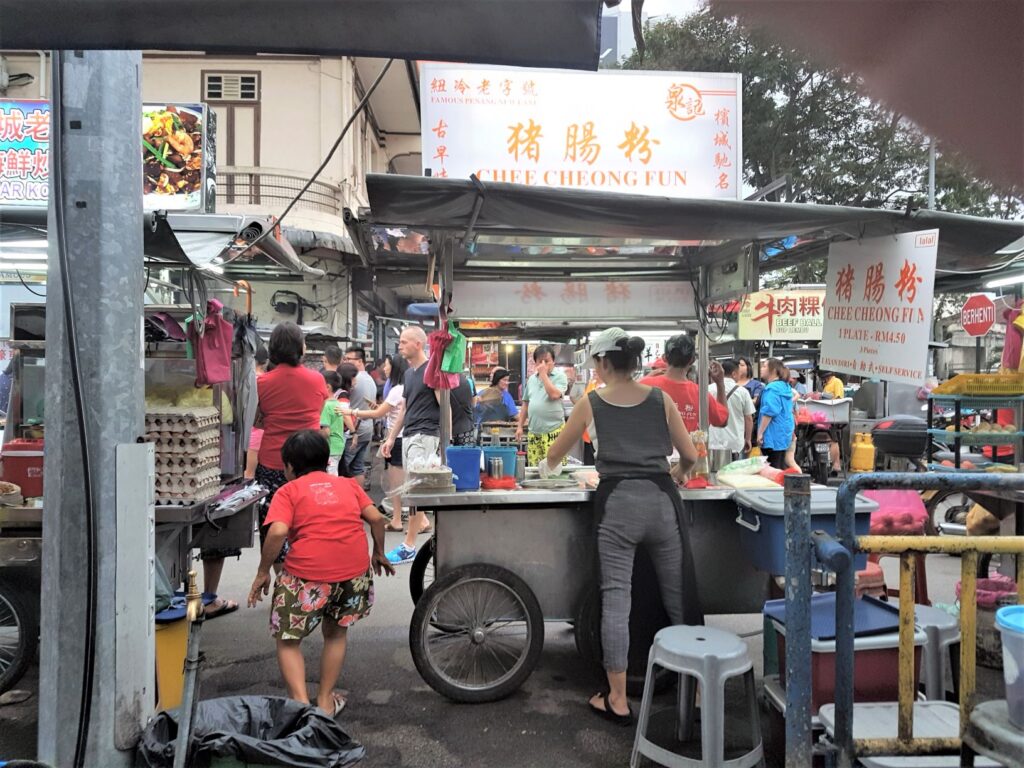
In Penang, each hawker center becomes a sought-out destination for your next meal, a new place to discover or return to favorites. Hawkers are cheap, informal, and almost universally delicious. Taste the local food and mingle with the people.
Overall, Penang street food delivers to all your senses; smells are intoxicating with aromas of spices that take you to faraway destinations. While the flavors are authentic in every way, producing mouth-watering euphoria in every bite. When completed, these extraordinary meals leave you wanting more and anticipating what future delights await you on this food discovery we call Penang.
Check out the local markets if you want to change it up from street food. The markets are an experience within themselves with exotic fresh fruits, vegetables, meats, and a great selection of fresh fish. The markets can be an assault on your senses, sight, and smell, so be forewarned. We often purchased from these markets to create our own meals in our apartment. Cindy and I loved the selection of everything, freshness, people, and the complete experience!
Our Popular Treats
It is hard to pick a favorite food, fresh Indian naan bread and curries were our most popular dishes. Let us not forget that Indian tea is a true delight to the taste buds and the coffee. The Chendol was one of the most surprising dishes. It is shaved ice with syrup, beans, and sometimes ice cream. Chendol didn’t look like much, but the flavors went well together.
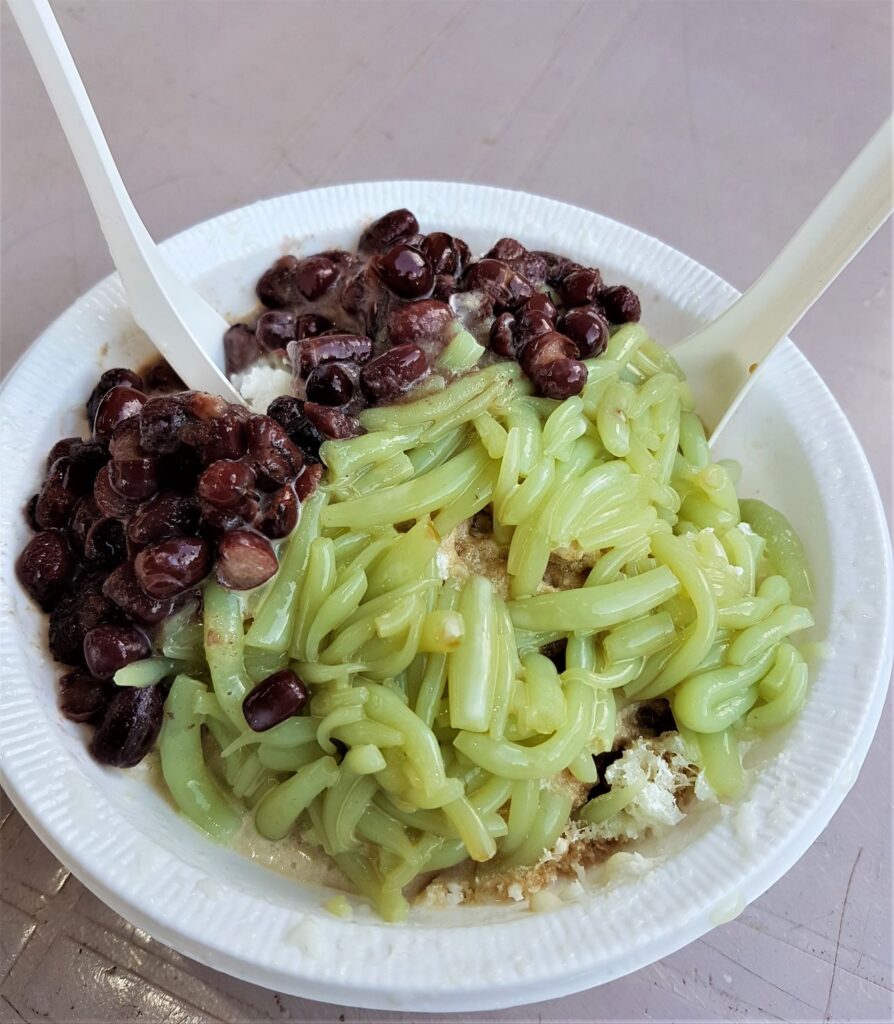
Durian Fruit
I do not think one can write about food without mentioning Durian Fruit. I personally like the taste of this fruit, Cindy, not so much.
I’ve been told there are two camps when to comes to Durian, Love it or Hate it, there is no middle ground.
If you’ve smelled a durian even once, you probably remember it. Even with the husk intact, the notorious Asian fruit has such a potent stench that it’s banned on public transportation.
I read somewhere its odor is best described as turpentine, onions, and garnished with a gym sock. I recommend trying; you never know.
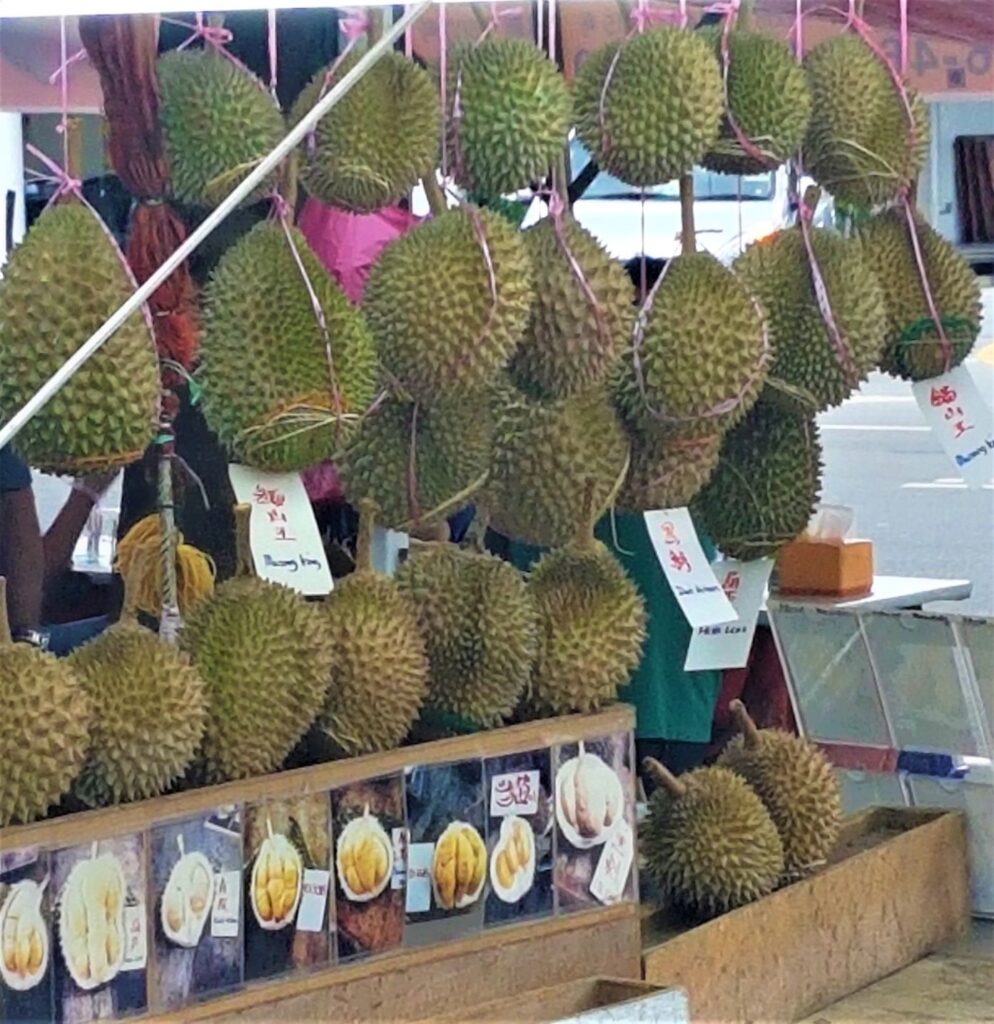
Penang What To Do and See, Places of Vibrant History and Culture
The following to-do and see ideas is by no means a completed list of what adventures await you, or are they in any order? We recommend visiting around CNY, as the incredible celebrations, activities, and food. These are just some suggestions that we enjoyed ourselves when we stayed in Penang. In saying that, time was on our side, as we had four months to experience the pleasures of Penang.
You will notice that I do not have Chinatown listed below, that is because most of historic George Town is in one form a Chinatown. The older buildings have a Chinese feel to them, the colors, and you will find many other temples and shrines. And many locations to try authentic Chinese cuisine.
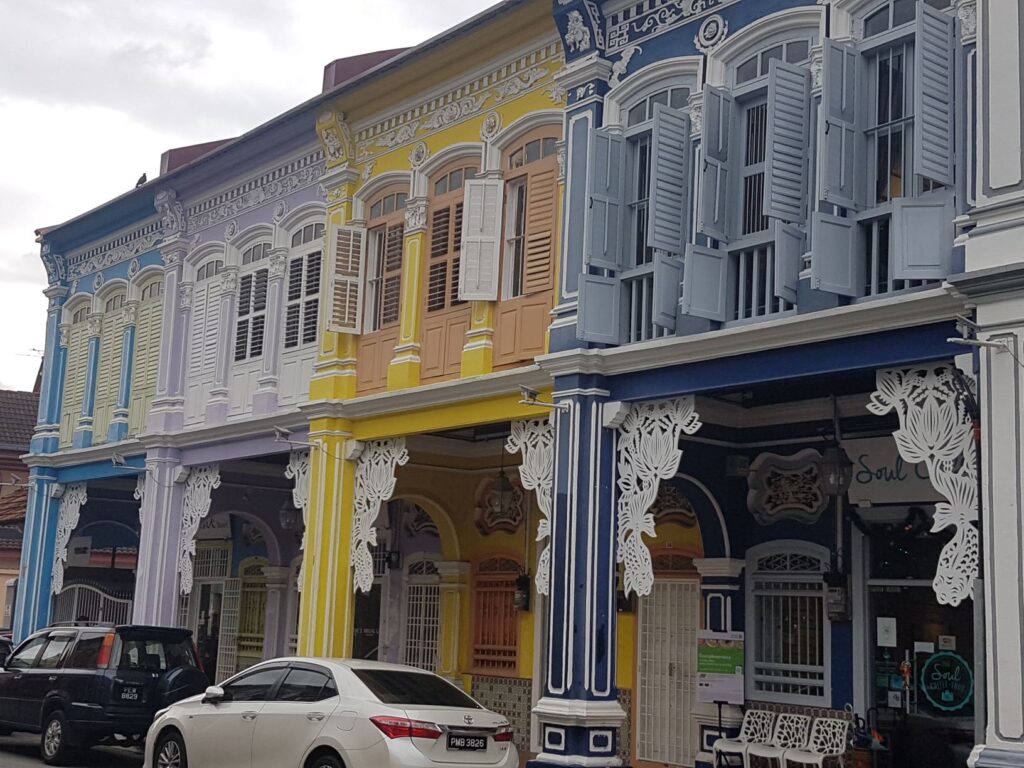
1. Experience Chinese New Years celebrations
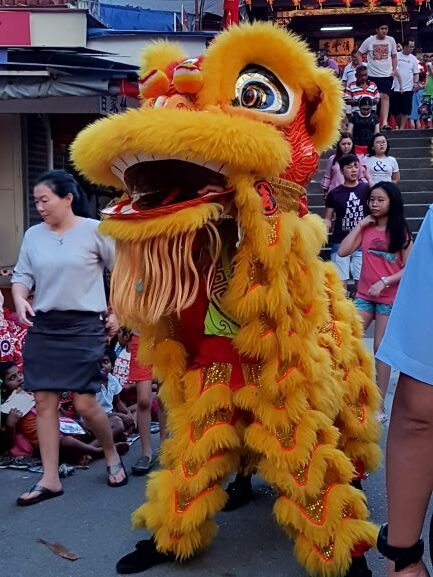
Chinese New Year is a celebration lasting approximately 15 days between the 3rd week of January and the 3rd week of February. The dates change yearly because the Chinese New Year Festival is based on the Chinese Lunar Calendar.
This festival is a must-see because George Town has a substantial Chinese population, and they go all out to showcase their culture and heritage. I read somewhere that Penang George Town has the largest New Years Celebrations outside mainland China. Truly an experience to take in.
Fireworks, parades, and food make this celebration a once-in-a-lifetime experience. I know that we will never forget what an incredible time this all was.
2. Clan Jetties
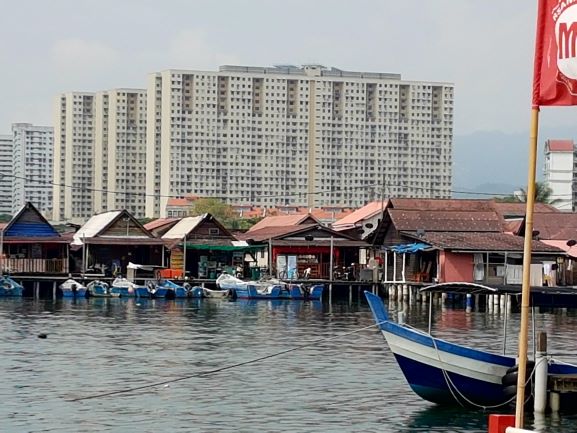
Clan Jetties form part of the Penang Heritage Trail. There are six jetties; each jetty is named after a Chinese clan.
The Chew Jetty is the most tourist-friendly, with the most stilt houses. Longest walkway, a temple worth stopping by, and plenty of places for memorable pictures.
The Clan Jetties are a truly amazing experience when visited during the celebration of the Chinese New Year, with fireworks, entertainment, and food.
3. Kapitan Keling Mosque
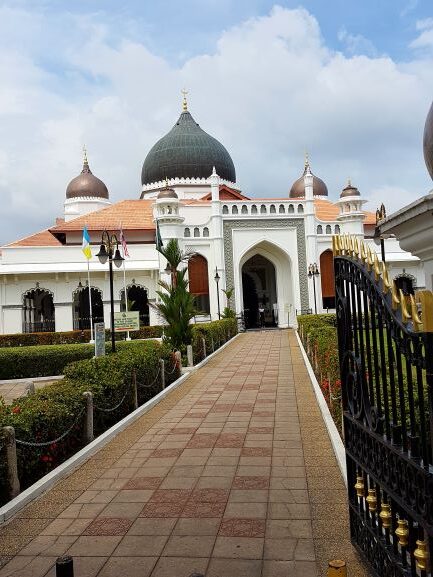
Keling Mosque is a Penang landmark. The largest mosque in the city, it is part of the World Heritage Site of George Town. Built-in 1801 by Penang’s first Indian Muslim traders (East India Company).
The whitewashed mosque is topped with large golden-yellow Mughal-style domes, crescents, and stars. Cauder Mohuddeen Merican is the founder of the mosque. He was called ‘Kapitan Kling,’ thereby giving the mosque its name.
Living history is what makes George Town so unique, the diversity in culture. A beautiful structure indeed. Make you that you make it over to Little India as the foods and sounds are like visiting India.
4. Kek Lok Si Temple
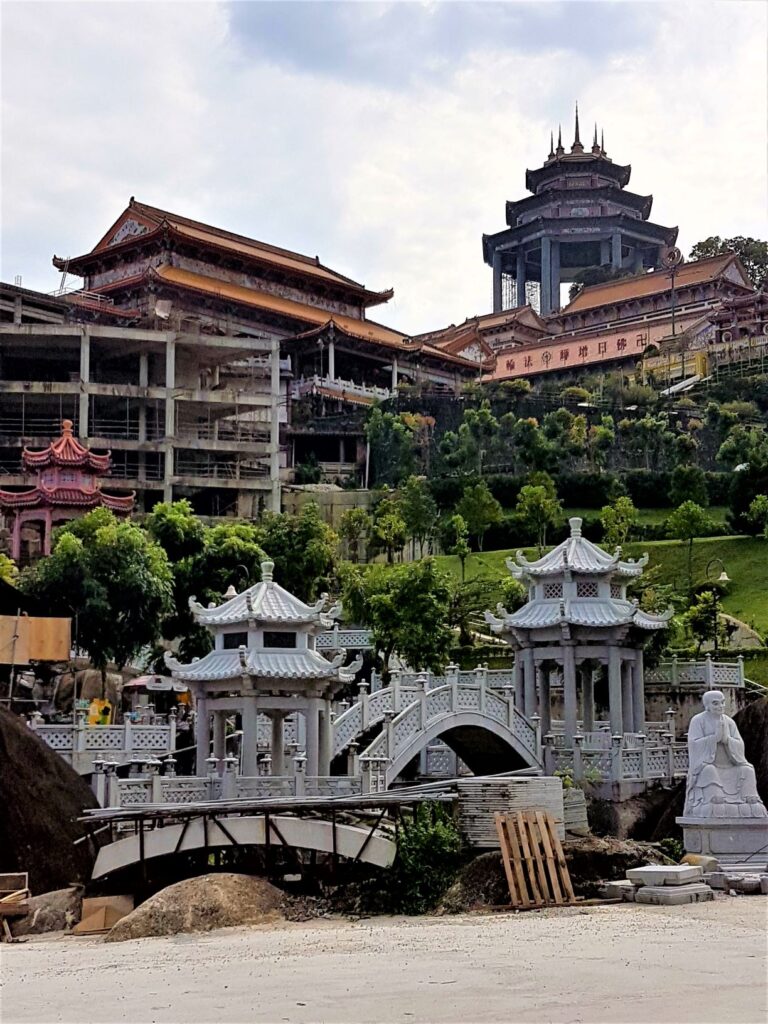
Kek Lok Si Temple is a must-visit in Penang, a wonderful site that takes a day to see and appreciate. Lite up during the Christmas season, but ultimately an overload of your senses when seen during the evenings of the Chines New Year. Breathtaking.
Situated on the hilltop at Air Itam near Penang Hill, Kek Lok Si is one of Southeast Asia’s largest Chinese Buddhist temples. The temple complex is a chief pilgrimage for Buddhists consisting of monasteries, temples, and gardens.
Kek Lok Si translates to Temple of serene Bliss. The temple’s highlight is the seven-story white and gold Pagoda of Rama VI. Different sculpture carvings in the interior and exterior and the temple’s elevated position provide an extraordinary view overlooking George Town and Penang.
5. Fort Cornwallis
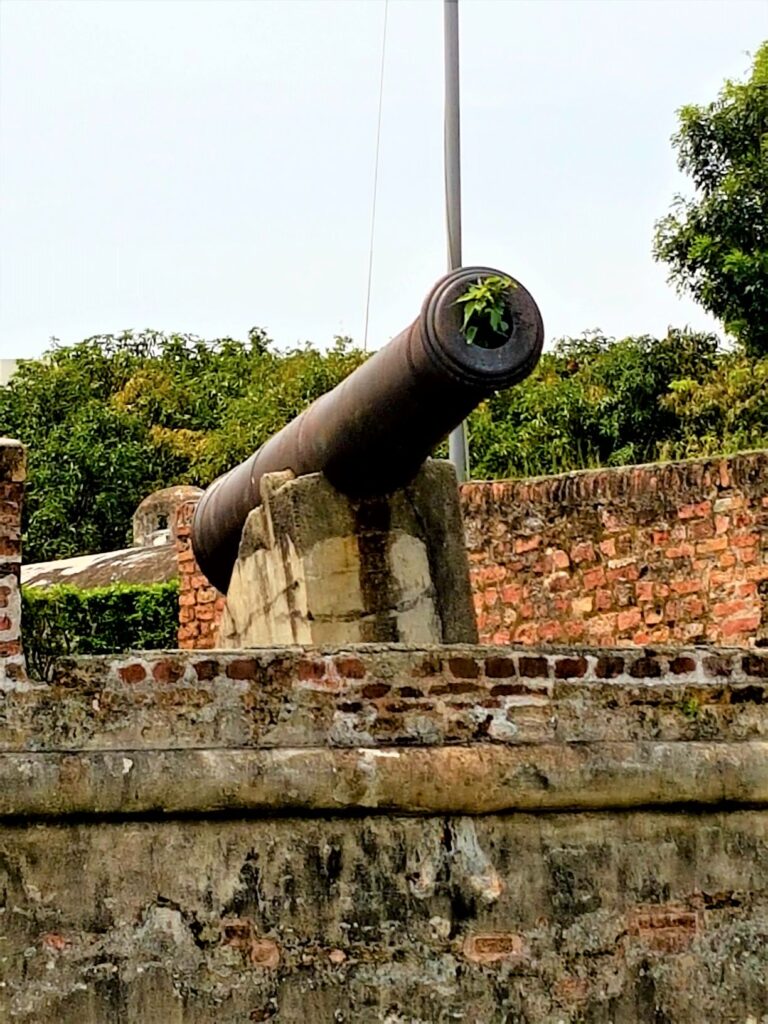
Fort Cornwallis (Kota Cornwallis in Malay) is one of the most important structures in George Town, Penang. Built in 1786, it is the largest intact standing fort in Malaysia. Fort Cornwallis was once an impressive star-shaped bastion intended as a defensive structure against pirates, Kedah forces, and even the French during the Napoleonic Wars.
Named after Charles Marquis Cornwallis, the Governor-General of Bengal, Fort Cornwallis’s design is much like that of other British forts in India. Fort Cornwallis’s interior stands a bronze statue of Captain Francis Light, along with barracks, munitions storage areas, and prison cells.
Today only ten-foot-high outer walls remain, with an enclosed park within. If you have time, Fort Cornwallis is a site worthy of a visit. This fort is a piece and part of what makes George Town so interesting and culturally diverse.
6. Penang Street Art
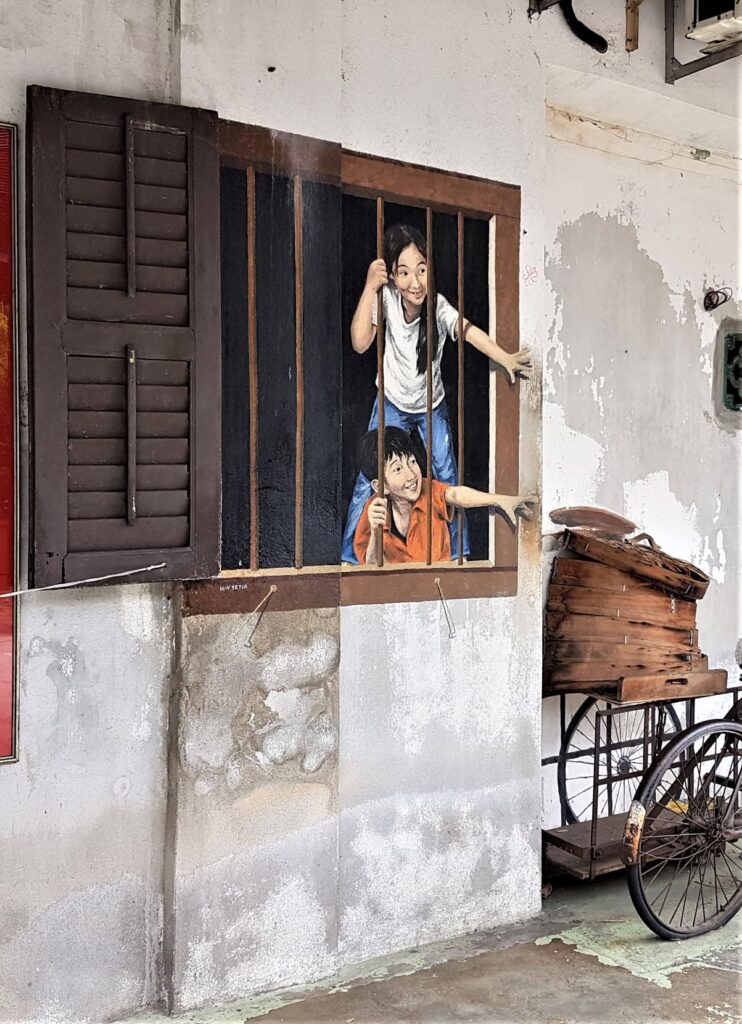
Taking a walk through Georgetown’s streets can be very rewarding to the eyes. Penang is known for its street art, in the inner city, from murals to small sculptures displaying life in Penang. You will see many unique pieces of art throughout the streets, and the trick is to keep your eyes open so that you find them.
In 2012 Penang hired London-trained Lithuanian artist Ernest Zacharevic. Tasking him with breathing new life into some of the atmospheric Chinese shop-houses around the inner city. This created awareness of the rich history of the streets, the project was a success. His art turned areas into thriving tourist destinations that also became the much-talked-about object of attention among locals.
The street artwork is spread out across Penang’s city center. The most widely known is ‘Little Girl In Blue,’ a mural of a young child dressed in ocean blue pajamas flanked by the two real windows of its ‘canvas’ – a building along Muntri Street
7. Sri Mariamman Temple
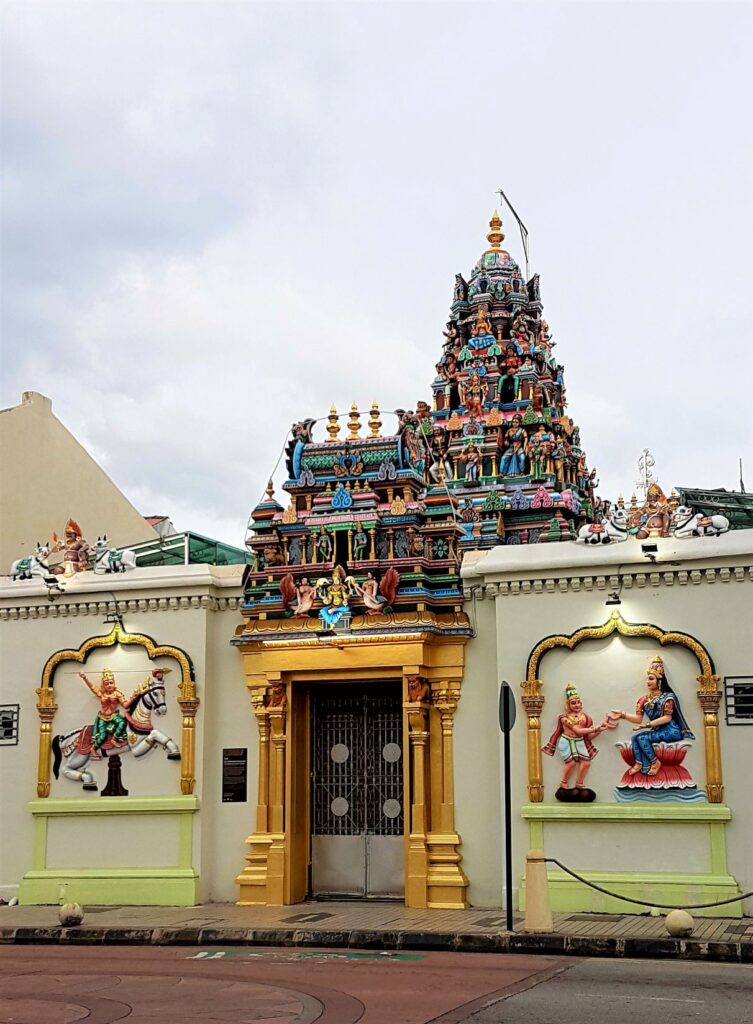
Sri Mariamman Temple is a Hindu temple dedicated to the Hindu god, Lord Subramaniam. Located on Lebuh Queen street in George Town’s compact Little India district.
Early in Penang’s history, the Tamil Indians arrived at the island’s bustling harbor and established their own ‘Little India’ community in the city. Built originally as a shrine in 1801. Around 1833 a proper temple for worship was constructed to accommodate the ever-increasing Indian community presence on Penang island. Sri Mariamman Temple has stood at the same location for more than 200 years.
Sri Mariamman Temple is a typical Hindu architecture, built in the southern Indian Dravidian style.
8. Penang Hill
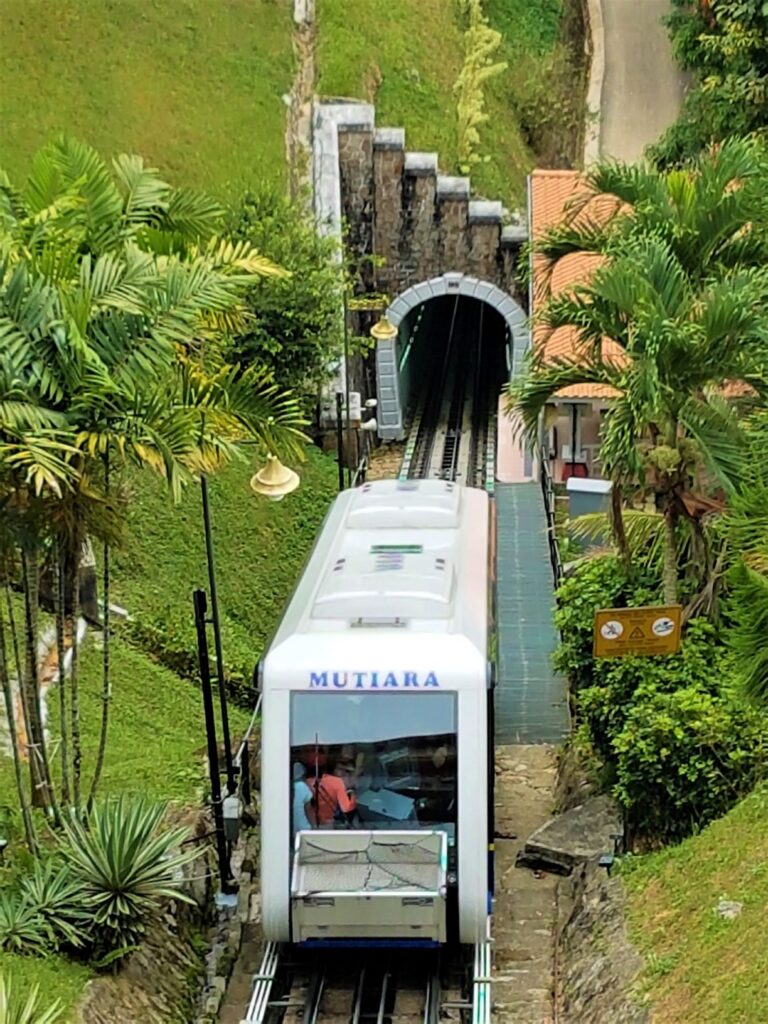
Penang Hill is located in the Air Itam suburb just 9 kilometers west of central George Town. Set at an elevation of 833 meters, Penang Hill station comprises of several hills. This popular tourist destination was originally used as a retreat by British officials in the colonial period.
Penang Hill’s unique funicular railway system takes you to the top of Penang Hill. Visiting the top of the hill is a convenient and exciting ride attracting millions of tourists. Along this journey in the Swiss-designed funicular cars, one can spot bungalows of pre-colonial areas amidst the lush green vegetation.
A further perk of visiting Penang Hill is its cooler climate, luxurious vegetation, breathtaking views, and monkeys. Its restaurants, adventurous hiking trails, and high vantage points make it a much-loved destination to unwind and relax.
The funicular railway service to the top of the hill operates daily between 6:30 AM to 11:00 PM. The last train runs at 11:00 PM from the Upper Station down to the hill.
9. Wat Chayamangkalaram

Wat Chayamangkalaram, located in Pulau Tikus, a suburb of George Town, is a Thai Buddhist temple. Also known as the Chayamangkalaram Buddhist Temple, it is famous for housing one of the world’s longest reclining Buddha statue.
The gold-plated 33-meter reclining statue is the 14th biggest reclining Buddha statue in the world. The colorful Wat Chayamangkalaram also houses Yaksha, Buddha, Devas’ figures, and other mythical creatures throughout the temple complex. This magnificent religious place’s overall architecture has taken its inspiration from the traditional Thai Buddhist structures dating back to the early 1700s. Recommended, as this is a beautiful Temple and something unique in George Town.
10. The Penang Botanic Gardens
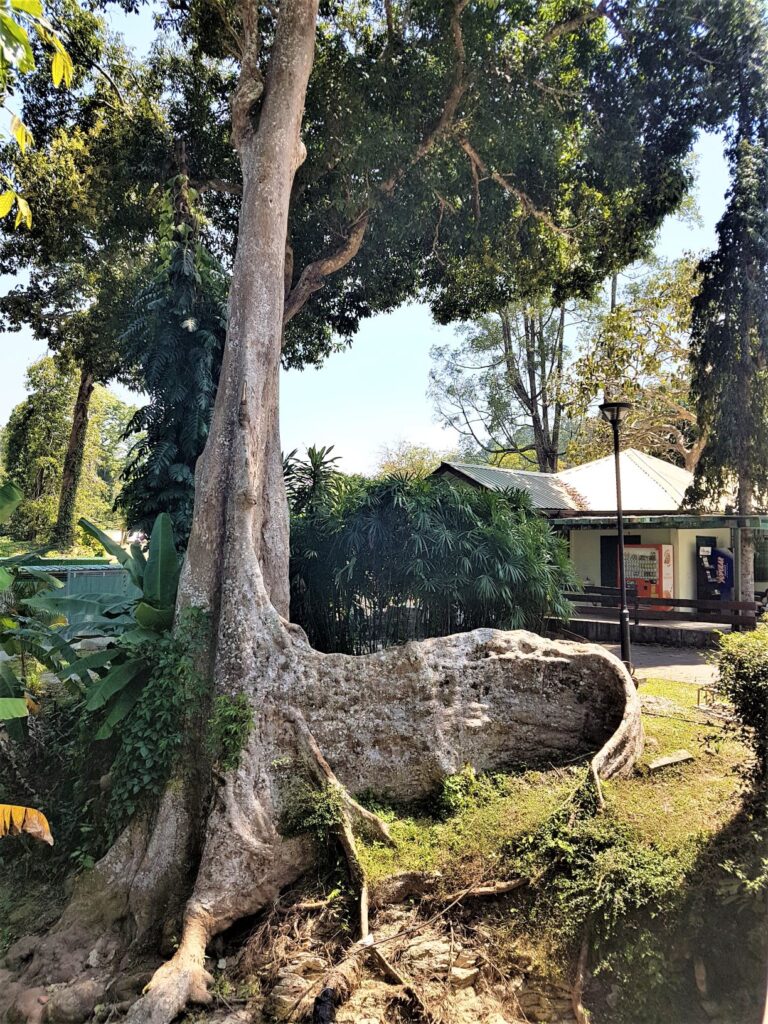
The Penang Botanic Gardens are located on Jalan Air Terjun Road in George Town. The beautifully landscaped gardens is a 50-hectare park, divided into twelve sections.
A leisurely stroll around the botanic garden is bound to reveal a variety of birds, giant squirrels, colorful butterflies, the lazy monitor lizards, and monkeys.
There are specially monitored areas where the temperature, humidity and other factors are maintained closely so that their natural habitats can be recreated. The desert plants like cacti and Himalayan plants are grown in such areas.
We recommend visiting the gardens as they are a beautiful respite from the hustle and bustle of George Town. Beautiful to see because of the waterfalls, trees, plants, and wildlife.
11. Penang War Museum

Penang War Museum is a former British military fortress that once served as the site for Penang’s legendary Battle against the Japanese army. Situated in Bukit Batu Maung on Penang’s southern coast, it now serves as a museum gaining fame as Southeast Asia’s largest war museum.
The Penang War Museum was a British bastion built in the 1930s as a defense structure against the Imperial Japanese Army’s sea invasion. However, the unexpected happened, and instead, the Japanese launched an aerial attack.
The British and Commonwealth troops had no choice but to evacuate the fortress. Thus, it came under the Imperial Japanese Army and was then used as an army base and prison. The Japanese used to interrogate, torture and behead the prisoners here which led to many ghostly stories being linked to it. When the war ended in 1945, the fort fell into disuse.
12. Little India
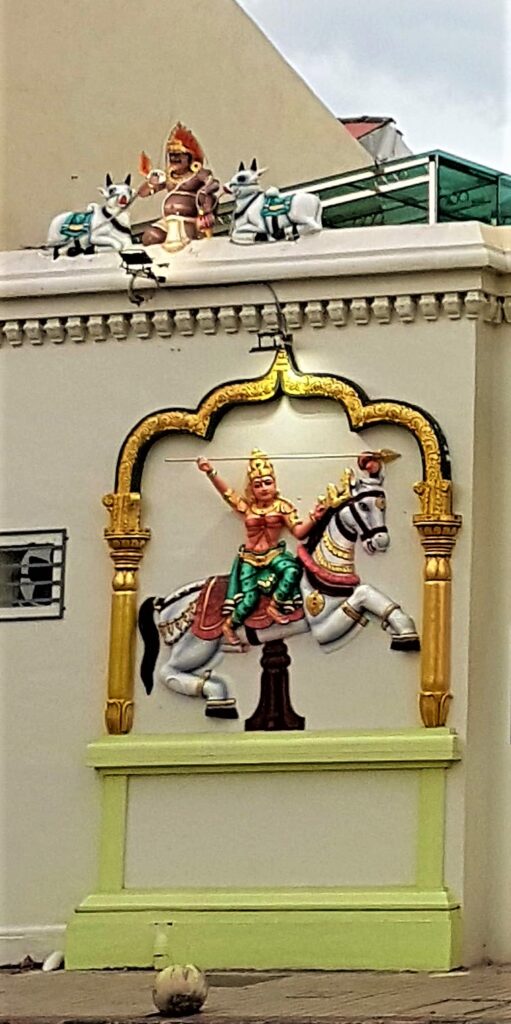
Little India is a small piece of India spread across four streets in Penang. The neighborhood captures the essence of India in its streets and is famous for its mouth watering food, streets filled with pizzazz from Bollywood songs, and the shops lined up selling wares from sarees to spices.
Often referred to as Little Madras by the British, the streets of Little India in Penang are abuzz at all times of the day and night. The neighborhood includes four main streets- Market Street or Jalan Pasar, the center place for all the action. Festivals and joyous occasions are also celebrated with as much zeal as the celebrations that are held in India.,
Little India is a treat to your senses for sure; it is abuzz with constant life. When visiting, you must try the foods as they are truly amazing and a pleasure to your taste buds. Break from your comfort zone and feel free to step inside the shops that offer once in a lifetime purchases.
13. The Cheong Fatt Tze Mansion
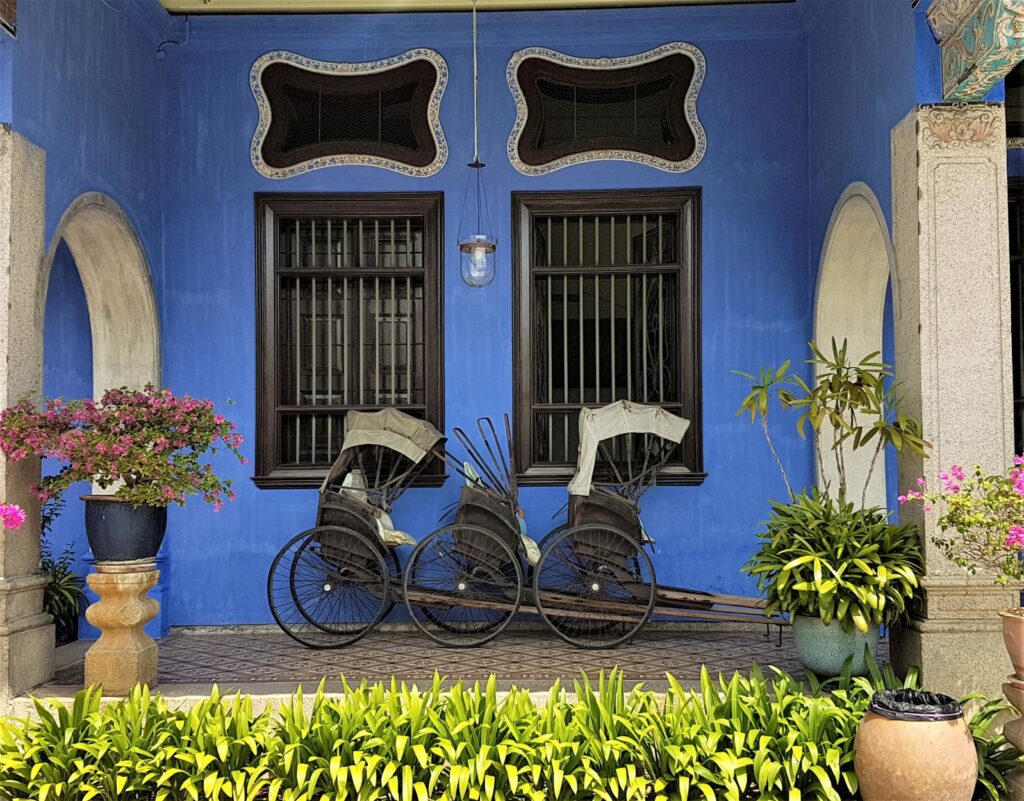
The Cheong Fatt Tze Mansion is a majestic UNESCO Heritage Site. Built in 1890 and was the home of Cheong Fatt Tze, who is also known popularly as the last Mandarin. The Mansion serves as a boutique hotel and museum. It is known as the Blue Mansion because of its distinctive blue-coloured outer walls and external decorations.
The Blue Mansion is located very close to many culturally areas of the city, such as Chinatown, the Clan Jetties Floating Village and Little India. The mansion offers guided tours, full of interesting bits of information for the curious traveler.
14. Penang National Park: Muka-Head Lighthouse/Monkey Beach/Turtle Sanctuary
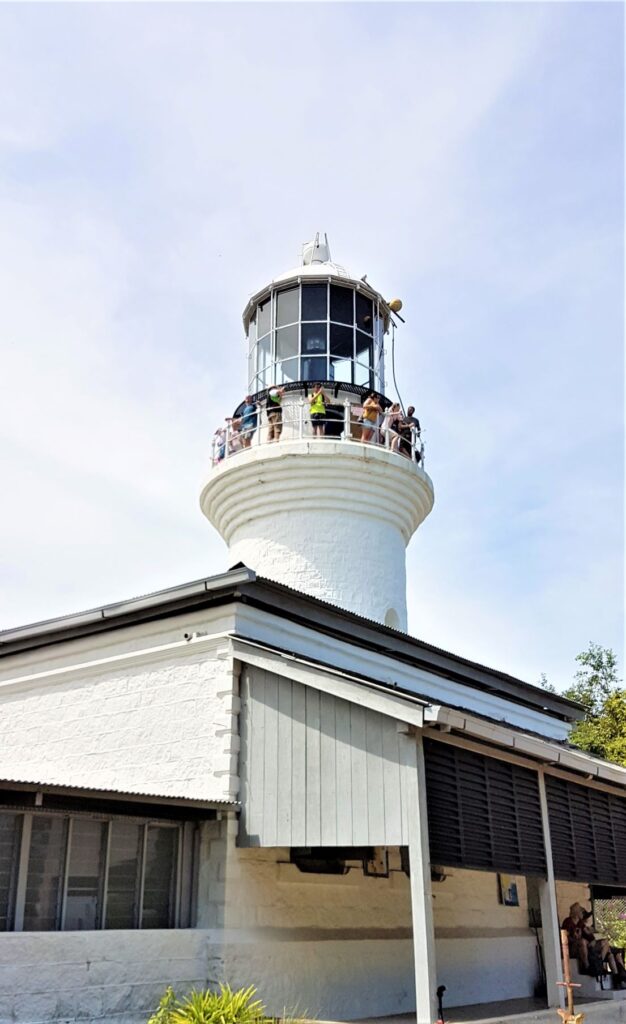
Muka-Head Lighthouse is a 14-metre high lighthouse, built by the British in 1883, located at the very north-western tip of Penang Island. The lighthouse is set on the top of a hill at an elevation of 227 meters, the only way to get here is by trekking up the hill from the western end of Monkey Beach.
The pathway up the hill starts off steep, but is nice and wide with steps, before narrowing into just a small narrow jungle track as you near the top. This is not a difficult trek and should take you 30 minutes to an hour depending on your level of fitness.
We found it to be a very difficult hike as we were very much out of shape when we arrived in Penang. If you have the time it is a beautiful hike just the same.
Monkey Beach so-called because of the Crab-eating Macaque’s that live around here, the beach is one of the nicest beaches in Penang Island, with a long stretch of white sandy beach that is good for swimming (beware of Jellyfish). Two ways to get to Monkey Beach, first by boat. Second, hiking in is just a bit less than 3 and a half km and takes most people under a couple of hours, but can be done quicker or much slower depending on your fitness and how many times you stop.
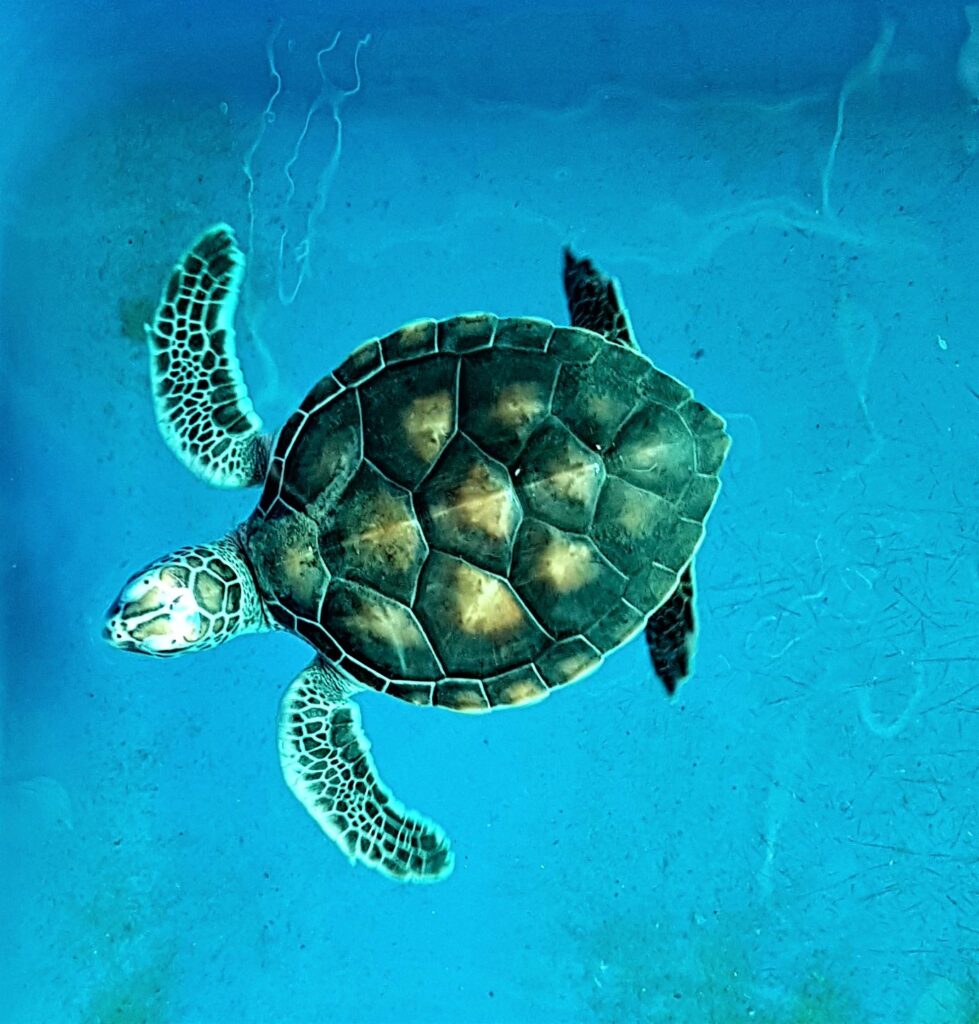
Turtle Sanctuary is located on Kerachut Beach (also known as Turtle Beach) and was set up to help protect and preserve Turtles’ dwindling populations in Malaysian waters. Various Turtle species come onto the beach at night to lay their eggs.
This is a nice hike of approx 2 hrs from the entrance to the beach. Being such a beautiful beach, and especially if you have just walked through the rainforest and are hot and sweaty, you may be tempted to take a swim. Before you do, take a walk out along the jetty. Unfortunately, this beach has a bit of a problem with Jellyfish (we have a jellyfish story).
15. The Jubilee Clock Tower
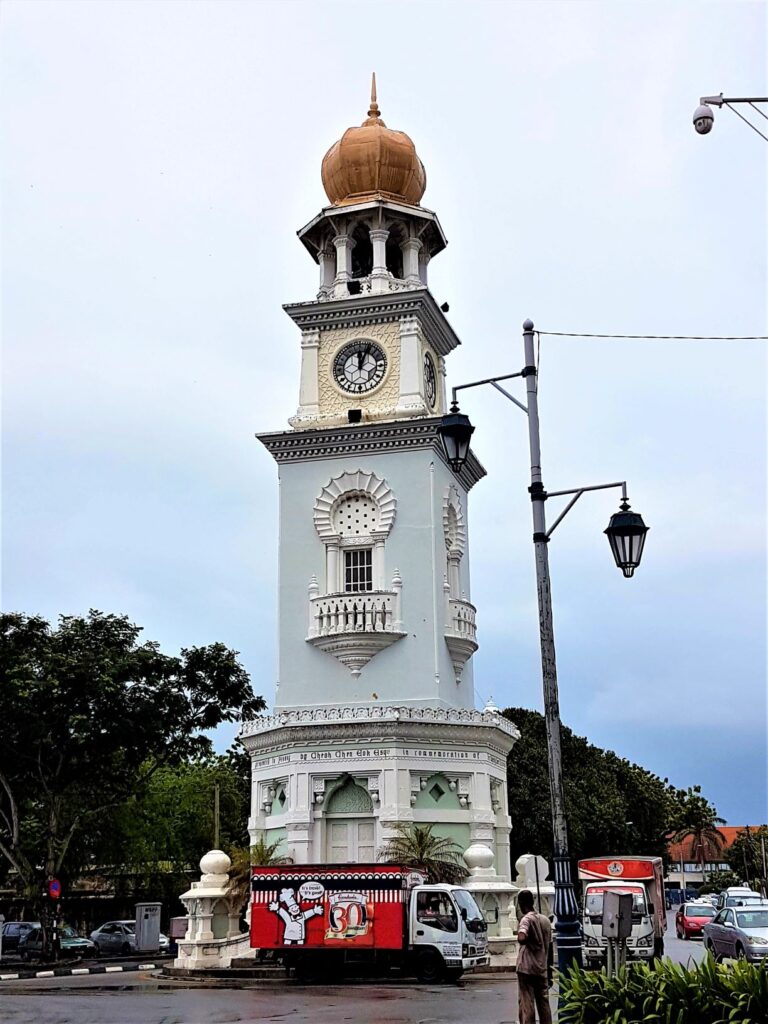
The Jubilee Clock Tower is a Moorish-style (western Islamic) Jubilee clocktower at Light Street and Beach Street’s junction. Built to commemorate Queen Victoria’s Diamond Jubilee.
The Queen Victoria Memorial Clock Tower is a testament to Penang’s royal connections. Commissioned in 1897 by a local millionaire, Cheah Chen Eok, to commemorate Queen Victoria’s Diamond Jubilee, it stands 60ft-high, with each foot representing a year of the Queen’s 60-year reign.
Interesting fact: although it is hardly noticeable, due to the impact from bombs being dropped around it during WWII, The Queen Victoria Memorial Clock Tower leans to one side, much like the Leaning Tower of Pisa.
16. Bukit Jambul/Air Itram Dam Loop Hiking Trail
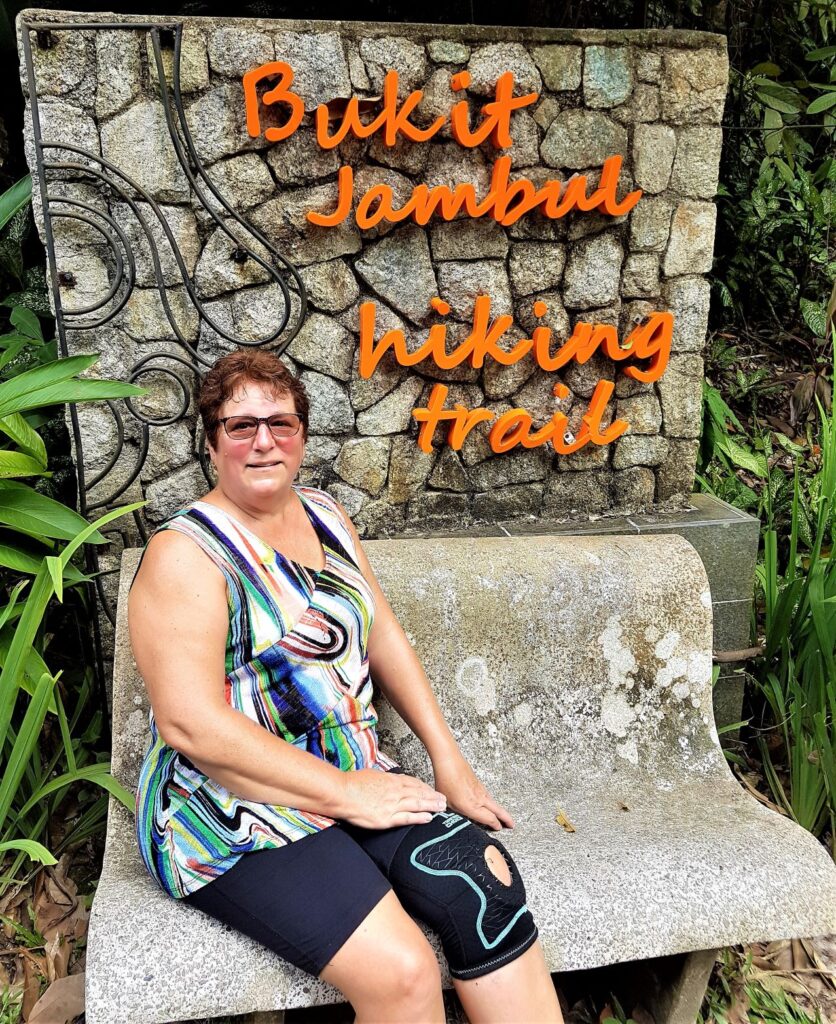
Bukit Jambul is a trail located near Bayan Lepas, a residential district 10km (6mi) northwest of George Town. It features beautiful wildflowers and is a moderate hike. The trail is primarily used for hiking, walking, and nature trips and is accessible year-round.
Bukit Jambul trail looks pretty unassuming at first, but it hides a hiking route that is paved with large stones. Distance covers around 1.3km uphill, making it a short ascent with a rewarding view when you reach the top.
As you go along the trail, you will enjoy the serenity and time away from the hustle and bustle of city life. You will get a chance to see a picturesque view from the hilltop where the first and second Penang bridges can be easily spotted.

Air Itam Dam Loop is a 2.7 kilometer moderately trafficked loop trail the views and the tranquility really set this route apart from others. Features a lake and is primarily used for hiking and walking.
The Air Itam Dam was first opened in 1962 to create a reservoir and sits around 210m (690ft) above sea level. This means that the air is clear and crisp, and doesn’t tend to be as foot traffic-heavy as some of the other routes around Penang.
Cindy and I caught a bus to Kek Lok Si temple and walked up the windy road up to Air Itram Dam Loop. Difficult to walk as it was very steep and curvy, this route did push our limits, pleasant views, and experience just the same.
17. Sam Poh Footprint Temple
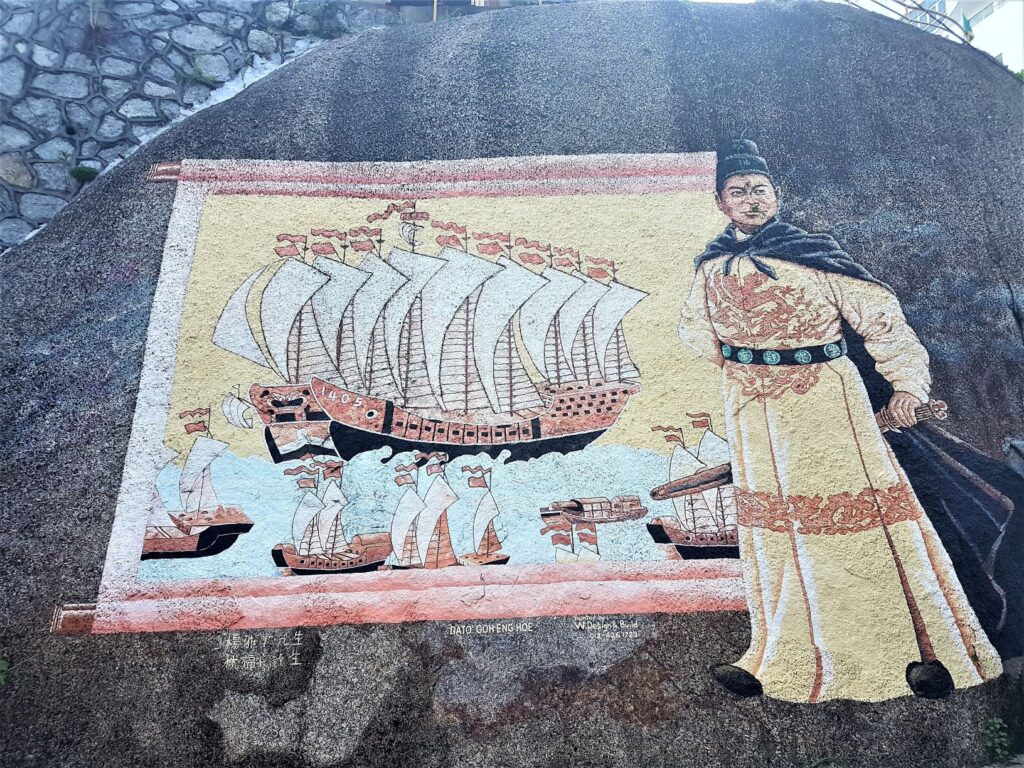
Sam Poh Footprint Temple is a small and beautiful Chinese temple facing the sea. Located in a small fishing village in Batu Maung at the far south end of the Penang island.
This temple is dedicated to Admiral Cheng Ho (also known as Zheng He / Sam Poh Kong). It is worth visiting to view a unique giant footprint set in stone located at the front of the temple. There are several interesting versions of how this footprint came to be.
18. Komtar Tower
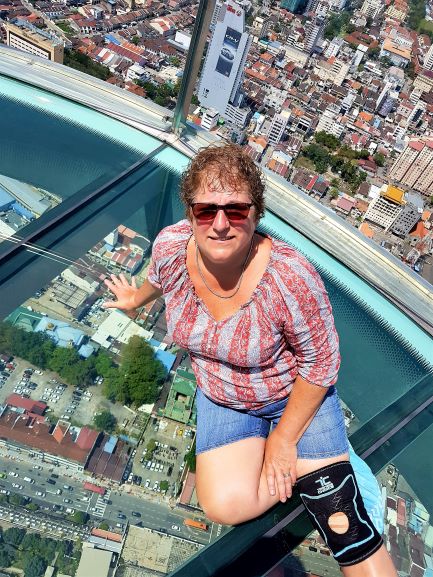
The KOMTAR at The Top Tower is the state’s tallest skyscraper plus lots more. The Rainbow Skywalk is here: it’s a horseshoe-shaped bridge that will let you stand a soaring 249-meters-high above George Town. Look down, and you will see streets, buildings, and cars reduced to miniatures.
The Gravityz is the most adventurous attraction. It’s a 90-meter-long rope course and zip-line attached to the exterior of Komtar’s 65th floor.
The lower levels of the Komtar offer many other adventures for the whole family. Included are an aquarium, Fruit Durian Museum, rides, and other adventures such as Jurassic Research Centre, Zombie Outbreak. As well as a 7D Discovery Motion Theatre. So this is a must-see!
Made It, We’re Snowbirding
As we sit at the airport waiting for our flight to take us away to sunshine and winter without snow. Over the intercom, we hear our flight is delayed due to fog. Thus after several hours of waiting, we finally board our flight, after our connecting flight with Delta has left for Hong Kong. This is our first winter away, and we are a bit anxious, not the way we wanted to start our travels. We are optimistic, sooner or later, we will arrive in Penang.
Delta Airlines in Seattle was very accommodating. Providing us with a dinner voucher and the promise of a flight to San Francisco. Then onto a flight with Cathay Pacific and onto Hong Kong. Things are definitely looking up.
Arriving in Hong Kong almost a day late, we missed out on our hotel reservation to provide a good night’s sleep. We are able to catch our original flight with Air Asia to Kuala Lumpur and then onto George Town Penang. We finally make it to George Town after a very long couple of travel days. Our Airbnb host picked us up at the airport and took us to our home for the next 2 months.
Why Malaysia
We picked Malaysia as our first winter getaway because they have a 3-month tourist visa, which we thought would be ideal, not having to move around too much. In total, we stayed in Penang for 4-months, two months at the start of our trip. Then a 1-month visit to Khanom, a small little fishing village in Southeast Thailand. After which another 2-months back in Penang

Our Introduction To Penang
We were grateful to David, our Airbnb host, for the exceptional accommodations that we found ourselves in 5 Mins to USM* Cozy entire apartment with kitchen. After a good night’s sleep, we open the bedroom blinds to see what at first looks like a jungle, no concrete here.
It was time to step out of our comfort zone and explore our surroundings, which we would be calling home for the next couple of months. We made our way down to the front of our apartment complex, where there were several outdoor kitchens. Here we ordered our first Malaysian breakfast.
Not only a pleasure to all your senses but was very filling, cheap and served by very friendly people. What a great first impression and sets the tempo for our Penang stay.
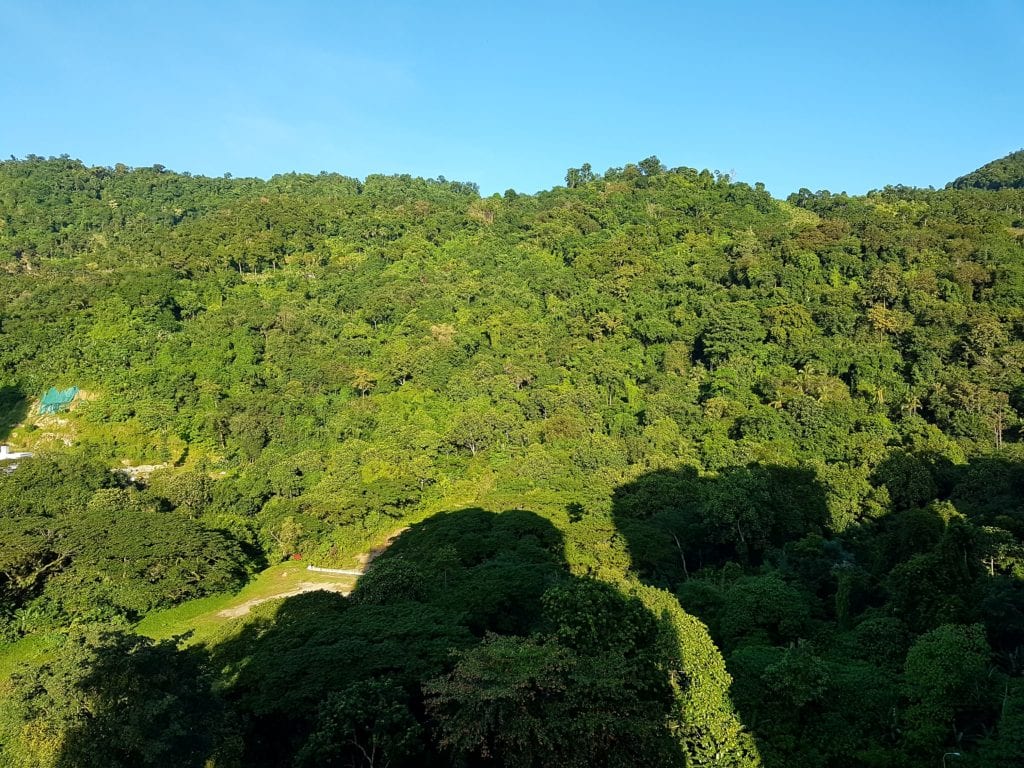
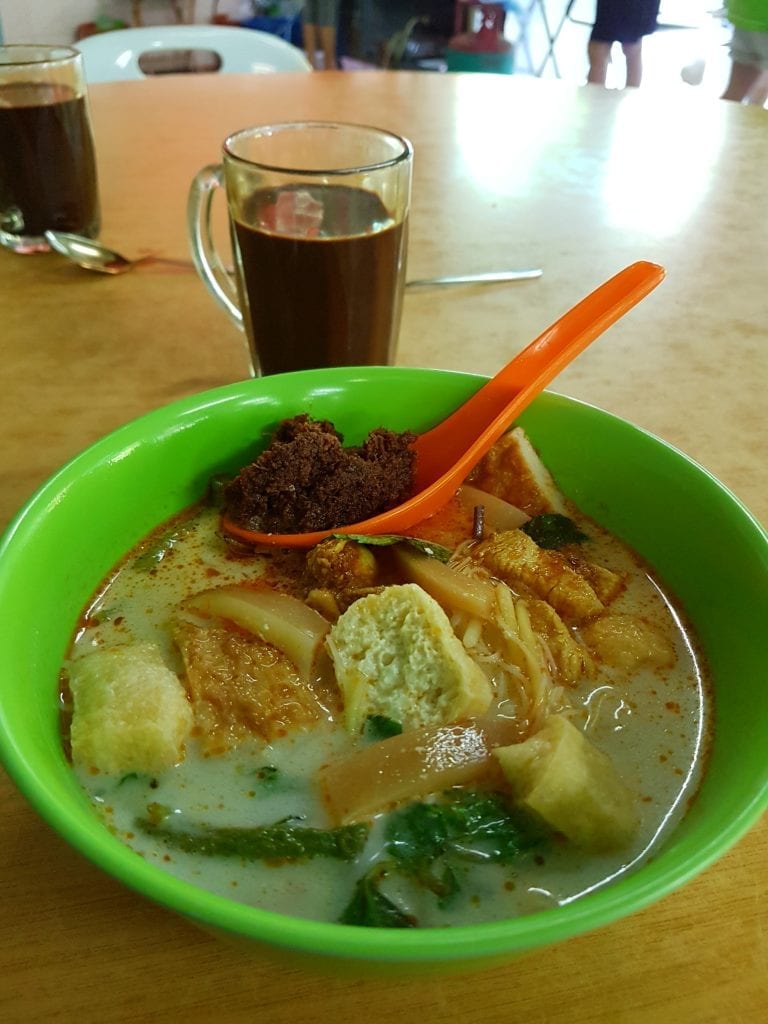
Beach at Batu Ferringhi
Meanwhile, after several days and getting our bearings, we decided to check out the public transportation system. As we had read that buses are a reliable and inexpensive mode of transportation to get around Penang (we used them a lot during our stay). Our apartment was in Gelgulor which was about 20-30 minutes from the downtown core.
Cindy and I thought we would go check out some of the beaches in an area called Batu Ferringhi; we do enjoy time spent on the beach. The bus ride turned out to be an hour & a half with a transfer at the downtown bus terminal. Happy to find the beach, and it was almost ours’s exclusively. The water was murky, but it looked very inviting so we ventured in.
What Horrors Await in the Shallows

To our shock, we weren’t the only things swimming in the water. Cindy felt something rub against her in the water and panicked; she quickly started moving in the shore’s direction. Before completing her first step, Cindy found herself entangled and consequently stung by a jellyfish, what we think was a boxer jellyfish. Through the sting, shock, and surprise, Cindy let out a loud squeal and rushes towards shore. I found myself in quick pursuit as I didn’t know what all the excitement was about. Arriving by her side on the beach. I find Cindy cradling her right arm and looking down in the direction of her lower arm.
By this time, she was screaming, and I could see that something wrapped around her arm. I pulled them off; It was part of the jellyfish’s tentacles that had stayed attached to her arm. At this point, Cindy screams at me to piss on her arm (everyone knows urine quenches the sting from a jellyfish). I don’t pee on command!
Temporary Relief From The Pain

After a short deliberation and Cindy in lots of pain, we noticed an older Chinese gentleman and lady at the change room entrance (they collected the monies to use the facilities). We go over to them and try to explain what had just happened and that it was a jellyfish sting. The gentleman appeared to be familiar with our circumstances. Quickly and gently, he started to apply some soothing salve onto the stinging rash. Then motioned to Cindy to wipe it off after a few minutes.
The barbs from the jellyfish fell out with Cindy’s wiping action, plus the stinging subsided. Cindy and I conveyed our gratitude for his kindness and knowledge with the jellyfish incident. We didn’t dare go back in the water the whole time we were in George Town.
Jellyfish Sting Follow Up
Cindy later had to go to a pharmacy to get cortisone cream. As the rash from the jellyfish sting continued to bother her. In fact, truth be told it took several months for the jellyfish sting marks on Cindy’s arm to disappear. Finding out later that vinegar can be used to help with the stinging of a jellyfish. In Thailand, we did carry a small bottle just in case.
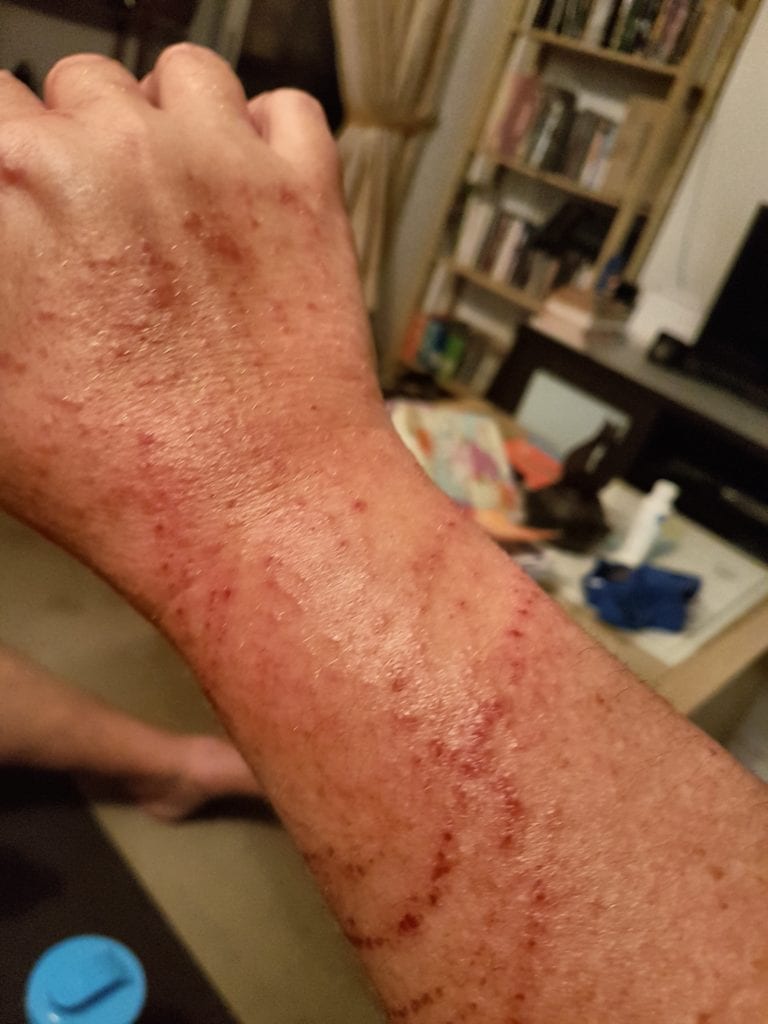
A Small Rain Shower
Headed to downtown Georgetown to enjoy another day of walking around George Town and touristy site, seeing there is still so much to see. Little did we know what the rain showers had in-store; it poured everywhere we went. We got to the point that we had difficulty trying to stay dry. After about half a day of this downpour, we decided that we had had enough.
Before heading back home, we would stop at our favorite market; from there, we caught our bus and headed home. Looking out the bus window, we could see that the downtown streets looked flooded with 15 to 30 cm of water. The next morning we found out that over 250 mm of rain had fallen in the past 16 hours. Never have we ever experienced rain like that, insane.
Consequently, all this rain was to play havoc on some of our future excursions around the area. Landslides closed attractions, walking paths, and other forms of mobility.
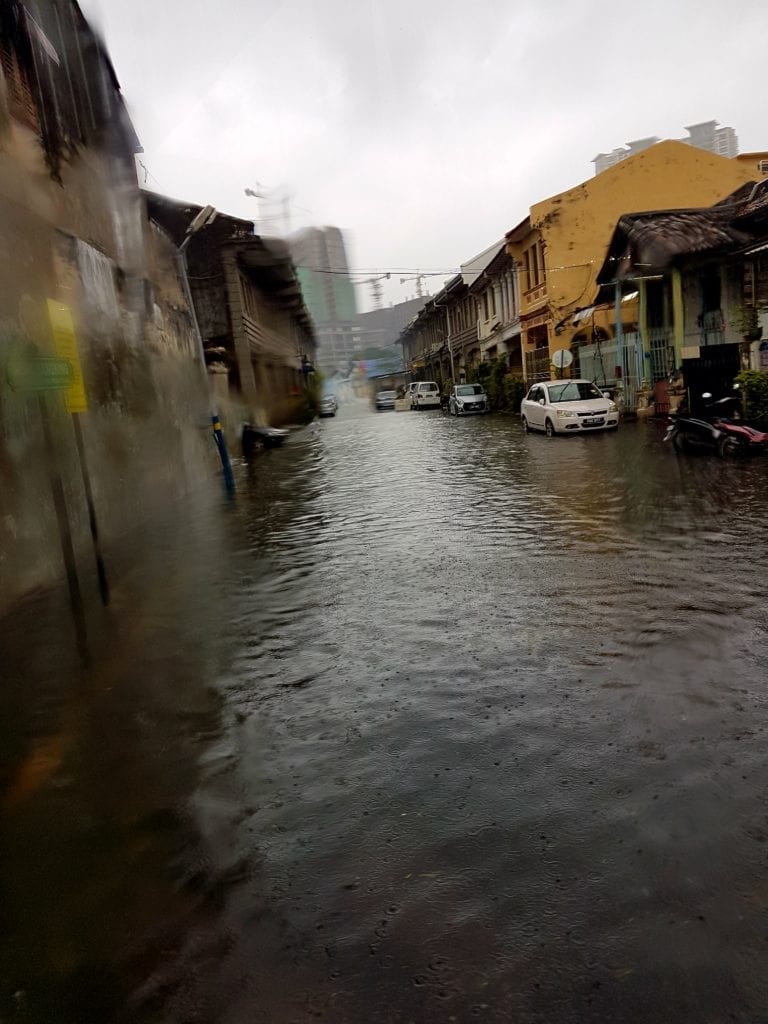
Our Love of A Good Walk/Hike
As you might know by now, we love to walk and visit local sites of interest. Walking here is hot, the temperature is always in the 30’s C and sunny, so hydration is a must. We made the best of what Penang had to offer when it came to walking to local sites or looking to hike some of the trails. Walking we find to be a good form of physical activity.
When we first arrived, we found out just how out of shape we really were. But after five months of walking daily 10+ Kms a day, we definitely improved.
Muka Head Lighthouse Hike
One of our first hiking destinations was to be Turtle Sanctuary/Beach. The walking paths to this area were closed due to downed trees and washouts from the recent rainstorm. At the park entrance, another destination was suggested, Monkey Beach and then a hike up to Muka Head Lighthouse. After a short boat ride with a young couple from Romania, who were vlogging/blogging their adventures as they traveled the world (this sounded like a good lifestyle).
Well, the walk up to the lighthouse was grueling, to say the least. It’s a very vertical trek through the jungle in hot 35 C temp. Partway through we thought that we were going to die as we were out of shape for such a hike. Our perseverance paid off. We accomplished the first of many long hard treks that we would attempt in Malaysia.





Our Adventures In Penang
In one form or another, we participated in all of the historical and cultural sites listed above, plus many more. We can’t write here about all of our adventures as this would become a book and not a blog. Needless to say, being in Penang for 4-months provides ample time to explore this wonderful exotic location. We captured the majority of our excursions within this blog but there is always more to see and do in Penang!
Planning a Mainland Excursion
Cindy and I needed to do a little research as we planned to visit a couple of towns on the mainland, Alor Setar and Ihpo. Our plan was to catch the train to Alor Setar, so we needed to locate the Butterworth train station. We were going to take a week and see something new, Alor Setar was more of a pick at random, but did have some history around it.
Ihpo is well known and has many interesting side trips that can be taken from this area with a rental of a car. To name but a few, Cameron Highlands is known for its growing of tea, Kelly’s Castle built by a Scottish planter, Tanjung Tualang Tin Dredge No. 5, and The Royal Belum State Park. Local attractions in Ihpo are Kek Lok Tong Temple, Concubine Lane, plus many others
Final Thoughts On Penang
- Cindy and I loved every minute in Penang, Malaysia. Highly recommend visiting, be it a short couple of days or a long stay as we did.
Our Positives
- English speaking, very safe, and friendly.
- Local foods are extraordinary, Chineses, Indian and Malay
- Incredible cultural sites to see, temples, Mosques.
- The freedom to walk everywhere, enjoying sites and new experiences
- Easy and affordable public transportation
- Wilderness mixed with city life.
- Heath life, I lost 40 pounds and Cindy 30 pounds in the four months that we lived here.
Our Negatives
- There are no beaches to swim at without the possibility of running into jellyfish.
- Garbage is found in the outlying areas of Penang; this appears to be a global problem.
Would have, Could have, Should have
- Should have stayed in a different location for our last 2 months.
- We should have visited Singapore since we were so close.
- Could have rented a car for a day or weekend to tour the island.
Next Stop
Well, we are off to Khanom, Thailand, a small fishing village southeast of Surat Thani by approx 1 hr. We are staying in Khanom for one month and then back to Penang. After leaving Penang to go home, we have a stop in Hong Kong for six days.
Support Our Blog, And Its Unique Travel Content
You can support our site by using the links through our travel Essential. We will receive a small commission if you purchase items using our links. There are no extra or hidden costs to you. These commissions assist us in our travel, so we can provide unique content to you through each blog post. If you enjoy our blog and find it interesting and informative, please share it with friends. Subscriber, so you never miss a new post. Thank you.
Recommended Travel Essential
Cindy and I call ourselves nomadic so with this lifestyle, we use certain essentials to make this way of life easier and more comfortable. With this in mind, we have composed a list of what we feel are essentials and some tips you might use to plan or take your next travel adventure.
- Travel Packing Essentials to help organize and make this task less stressful
- Travel Safety Essentials to make your life on the road a little safer, giving you peace of mind
- Living Essentials to make life a little more comfortable, be this resting, working, or playing.
Accommodation Options While Traveling The World
- Booking.com is one of our go-to’s when looking for a place to stay for a couple of days or longer.
- Agoda.com, we find, is best to use when in Southeast Asia, but hey, you never know what you might find.
- Airbnb.com used to be our go-to, but some of their cancelation policies are reasonable, give them a try as well.
Travel Insurance
We always travel with some travel Insurance, be it just medical or complete trip coverage. Remember, don’t travel without coverage, the savings are not worth the possible costs.
Some links on this page are affiliate links, meaning we may earn a commission if you buy a product using our link. This commission comes at no additional cost to you. Disclaimer.
